Editor's Note:
Dear Friend,
In a small community like mine (my wife and I codirect the Chabad center in Munster, Ind.), coordinating a minyan of 10 men for every Shabbat can be a challenge. Despite our best efforts, we often end up with a minyanless service.
Not so for Shavuot.
Beginning a week or so in advance, I will call, email, and text our friends in the community asking them to make an extra effort to attend. Of course, in typical Chabad style, we offer a delicious dairy buffet of cheesecake, blintzes, pasta dishes, and more (and of course ice cream with lots of toppings for the kids).
Why all this? Because on Shavuot, as we stand in the synagogue listening to the Ten Commandments read from the Torah, we are actually standing before G‑d, agreeing to become His nation once again. And just like at Mt. Sinai, where every single Jewish soul of all future generations was present, every Jew should also make an effort to attend a Ten Commandments reading at or her his local synagogue.
And, the Lubavitcher Rebbe—Rabbi Menachem M. Schneerson, of righteous memory—would always emphasize, this applies particularly to children, who are our future and the guarantors that Torah observance will always be a part of our being.
So click here to find a local Ten Commandments reading, and make sure to come and bring a friend.
Let us celebrate the Torah and internalize its messages,
Eliezer Zalmanov
on behalf of the Chabad.org Editorial Team

A Time For I
There are times to bend like a reed in the wind.
And there are times to act as a stubborn wall against the tide.
There are things that lie at the periphery of life. Then every “I hold like this” and “my opinion is . . .” stands in the way of harmony and peace. Every such “I” is the very root and source of evil.
But when it comes to matters that touch the purpose for which you were placed in this world, that’s when you have to be that immovable wall. That’s when you have to say, “On this, I‘m not going to budge.”
That “I,” that’s not evil. That‘s an “I” fulfilling the purpose for which you were given an “I.”[Likkutei Sichot, vol. 22, pp. 159–163; Behar–Bechukotai 5737:34]
This Week's Features:
Printable Magazine

9 Mind-Expanding Themes to Keep You Up All Night This Shavuot

Your Spiritual Fix: Late For Sinai
What was the real point of the Ten Commandments—what was said, or how? By Tzvi Freeman
• Quick Insight: Why an Eighty-Year-Old Played Charades with an Eleven-Year-Old (By Chana Weisberg)

9 Mind-Expanding Themes to Keep You Up All Night This Shavuot

Chabad-Lubavitch rabbis are putting the finishing touches on their programs for the first night of Shavuot, when it is customary to burn the midnight oil, studyingTorah all night until daybreak.
Nine different Chabad rabbis around the world were asked what they plan to study during the holiday with their communities.
These were their responses:
1. Start at the Beginning . . .
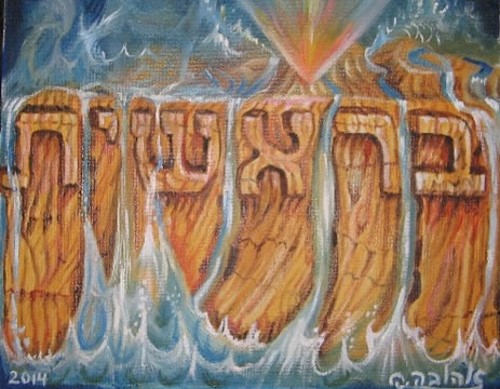
Credit: Ahuva Klein
The Torah begins with one word, Bereishit. Often translated as “in the beginning,” this one word is said to hold the keys to creation itself. Over the years, Kabbalists, homilists, chassidic masters and scholars of all stripes have peeled back layer upon layer of insight packed into those six letters. Shavuot night is a perfect time to explore the tip of the iceberg of Torah.
Learn more with Rabbi Yossi Yaffe, Chabad of the Shoreline, Guilford, Conn.
2. The Story of Ruth

Credit: Sarah Kranz
Shavuot celebrates the day when our ancestors stood at Mount Sinai becomingG‑d’s chosen nation. The book of Ruth tells a story of loyalty and generosity, as the Moabite princess Ruth follows her Hebrew mother-in-law to the Land ofIsrael. There she joins the Jewish nation, becoming the archetype for thousands of righteous converts who followed her path.
Deep in meaning, the four chapters of this book are the perfect narrative to explore the evening of Shavuot.
Learn more with Rabbi Chalom Loeub, Chabad Jewish Student Centre, Vancouver, Canada.
3. A Little Bit of Everything

Credit: Gify
The traditional syllabus for Shavuot night, known as Tikkun Leil Shavuot, is a summarized version of the entire Torah. It boasts selections from everyParshah of the Torah, as well as from the Tanach, the tractates of the Mishnah, and even major Kabbalistic works. It’s an impressive run-through of our entire tradition. The last section is Maimonides’ list of the 613 mitzvahs.
Learn more with Rabbi Bentzion Butman, Chabad Jewish Center, Phnom Penh, Cambodia.
4. Stump the Rabbi!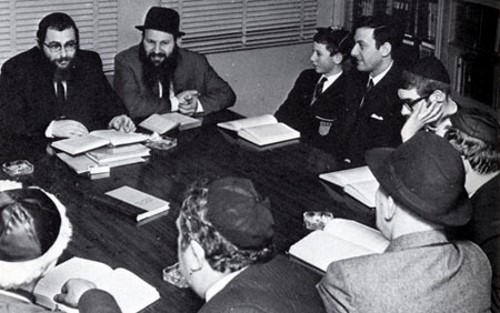
Why limit Torah study? We’ve only recently celebrated Passover, where theSeder centers around the Four Questions. But Jewish people have far more than just four questions, so we invite people to submit their questions in advance of Shavuot. After answering them, we open the floor for group discussion. People love it, and they manage to stay awake all night, peppering others with their insights.
Learn more with Rabbi Mendel Kaplan, Chabad @ Flamingo, Thornhill, Canada.
5. Feel the Depth
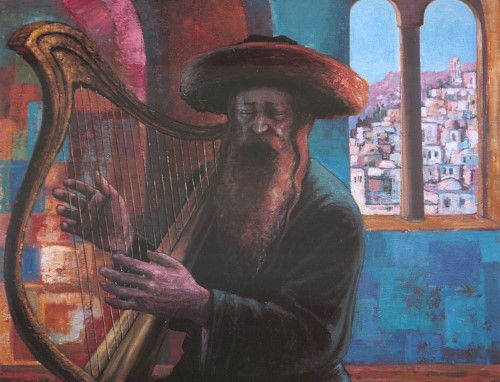
Credit: Zalman Kleinman
King David was a mighty warrior and a powerful leader. He was also a prophet, who wrote some of the most enduring words in our tradition, the book ofPsalms. Psalms are part of daily Jewish prayers and are very commonly recited. But how often do we have a chance to study them in depth? Shavuot, King David’s yahrtzeit, is a profound and relevant time to study them with some classic commentaries.
Learn more with Rabbi Yossi Marrus, Chabad Center for Jewish Life & Learning, San Antonio, Texas.
6. That’s ‘Rabbi Doctor’ to You!
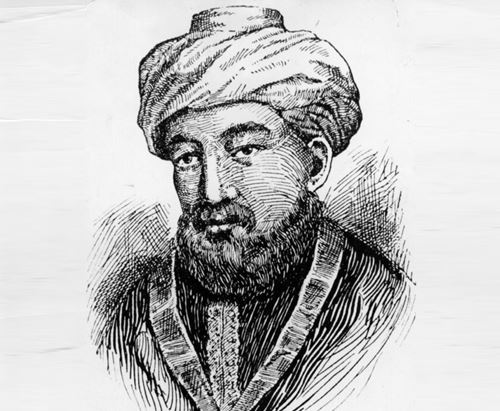
Credit: Wikimedia
Maimonides was one of the most influential teachers of Torah in the past millennium. Private physician to Saladin and a brilliant writer on a plethora of subjects, he will be long remembered as a philosopher and codifier of Jewish law. It is safe to assume that if not for his leadership, Torah would have been lost from some Jewish communities.
What better time is there to study the life and times of this great man—theMoses of his generation?
Learn more with Rabbi Yossi Jacobs, Lubavitch in the Midlands, Birmingham, England.
7. Remember: Keep It Fresh
 Credit: Gify
Credit: Gify
Some favorite ideas from past years include the observance of Shavuot (which is predicated on the 49 days of the Omer) for someone who has crossed the International Date Line, and other challenges to modern-day jetsetting Jews.
When it comes to the last hour, the most important thing to offer is something fresh—something that even the rabbi hasn’t learned before. That way, everyone becomes stimulated and awakened. The deep teachings of theRebbe work wonders for this.
Learn more with Rabbi Yossie Nemes, Chabad Center of Metairie, La.
8. Let the People Speak!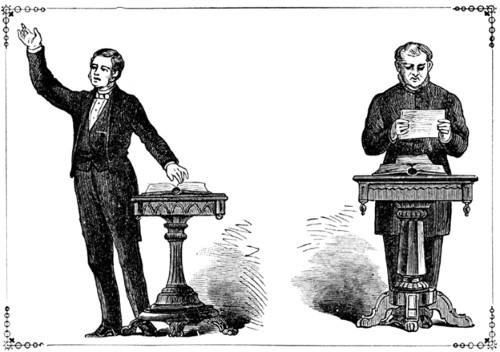
We have people from our community speak about something they are passionate and knowledgeable about; it’s both inclusive and educational. For example, a statistician will present “Statistics of Judaism in America, and Its Chance of Survival”; an exercise and physiology Ph.D. candidate will tackle “Torah and Exercise”; and this year, a microbiology Ph.D. candidate will enlighten all on “Torah and Microbiology.”
Learn more with Rabbi Chaim Lazaroff, Uptown Chabad, Houston, Texas.
9. Go Old School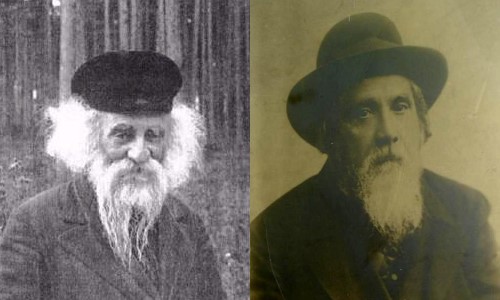
The Latvian town of Dvinsk (Daugavpils) was home to two great Torah scholars: Rabbi Yosef Rosin (the Rogatchover Gaon, 1858–1936) and Rabbi Meir Simcha (the Ohr Same’ach, 1843–1926). The former was a Chabadchassid; the latter was not. Both of them contributed greatly to Torah scholarship. Shavuot night is an amazing time to explore the history of this once-important Jewish town, as well as the teachings of the great men who immortalized its name. For the rest of the night we will study the book of Ruth, with classic and chassidic commentaries.
Learn more with Rabbi Levy Wineberg, Hama’or Centre, Johannesburg, South Africa.
For those of you unable to travel halfway across the globe to join the rabbis just described, find a Shavuot learning program near you by clicking here.
© Copyright, all rights reserved. If you enjoyed this article, we encourage you to distribute it further, provided that you comply with Chabad.org's copyright policy.
Nine different Chabad rabbis around the world were asked what they plan to study during the holiday with their communities.
These were their responses:
1. Start at the Beginning . . .

Credit: Ahuva Klein
The Torah begins with one word, Bereishit. Often translated as “in the beginning,” this one word is said to hold the keys to creation itself. Over the years, Kabbalists, homilists, chassidic masters and scholars of all stripes have peeled back layer upon layer of insight packed into those six letters. Shavuot night is a perfect time to explore the tip of the iceberg of Torah.
Learn more with Rabbi Yossi Yaffe, Chabad of the Shoreline, Guilford, Conn.
2. The Story of Ruth

Credit: Sarah Kranz
Shavuot celebrates the day when our ancestors stood at Mount Sinai becomingG‑d’s chosen nation. The book of Ruth tells a story of loyalty and generosity, as the Moabite princess Ruth follows her Hebrew mother-in-law to the Land ofIsrael. There she joins the Jewish nation, becoming the archetype for thousands of righteous converts who followed her path.
Deep in meaning, the four chapters of this book are the perfect narrative to explore the evening of Shavuot.
Learn more with Rabbi Chalom Loeub, Chabad Jewish Student Centre, Vancouver, Canada.
3. A Little Bit of Everything

Credit: Gify
The traditional syllabus for Shavuot night, known as Tikkun Leil Shavuot, is a summarized version of the entire Torah. It boasts selections from everyParshah of the Torah, as well as from the Tanach, the tractates of the Mishnah, and even major Kabbalistic works. It’s an impressive run-through of our entire tradition. The last section is Maimonides’ list of the 613 mitzvahs.
Learn more with Rabbi Bentzion Butman, Chabad Jewish Center, Phnom Penh, Cambodia.
4. Stump the Rabbi!

Why limit Torah study? We’ve only recently celebrated Passover, where theSeder centers around the Four Questions. But Jewish people have far more than just four questions, so we invite people to submit their questions in advance of Shavuot. After answering them, we open the floor for group discussion. People love it, and they manage to stay awake all night, peppering others with their insights.
Learn more with Rabbi Mendel Kaplan, Chabad @ Flamingo, Thornhill, Canada.
5. Feel the Depth

Credit: Zalman Kleinman
King David was a mighty warrior and a powerful leader. He was also a prophet, who wrote some of the most enduring words in our tradition, the book ofPsalms. Psalms are part of daily Jewish prayers and are very commonly recited. But how often do we have a chance to study them in depth? Shavuot, King David’s yahrtzeit, is a profound and relevant time to study them with some classic commentaries.
Learn more with Rabbi Yossi Marrus, Chabad Center for Jewish Life & Learning, San Antonio, Texas.
6. That’s ‘Rabbi Doctor’ to You!

Credit: Wikimedia
Maimonides was one of the most influential teachers of Torah in the past millennium. Private physician to Saladin and a brilliant writer on a plethora of subjects, he will be long remembered as a philosopher and codifier of Jewish law. It is safe to assume that if not for his leadership, Torah would have been lost from some Jewish communities.
What better time is there to study the life and times of this great man—theMoses of his generation?
Learn more with Rabbi Yossi Jacobs, Lubavitch in the Midlands, Birmingham, England.
7. Remember: Keep It Fresh

Some favorite ideas from past years include the observance of Shavuot (which is predicated on the 49 days of the Omer) for someone who has crossed the International Date Line, and other challenges to modern-day jetsetting Jews.
When it comes to the last hour, the most important thing to offer is something fresh—something that even the rabbi hasn’t learned before. That way, everyone becomes stimulated and awakened. The deep teachings of theRebbe work wonders for this.
Learn more with Rabbi Yossie Nemes, Chabad Center of Metairie, La.
8. Let the People Speak!

We have people from our community speak about something they are passionate and knowledgeable about; it’s both inclusive and educational. For example, a statistician will present “Statistics of Judaism in America, and Its Chance of Survival”; an exercise and physiology Ph.D. candidate will tackle “Torah and Exercise”; and this year, a microbiology Ph.D. candidate will enlighten all on “Torah and Microbiology.”
Learn more with Rabbi Chaim Lazaroff, Uptown Chabad, Houston, Texas.
9. Go Old School

The Latvian town of Dvinsk (Daugavpils) was home to two great Torah scholars: Rabbi Yosef Rosin (the Rogatchover Gaon, 1858–1936) and Rabbi Meir Simcha (the Ohr Same’ach, 1843–1926). The former was a Chabadchassid; the latter was not. Both of them contributed greatly to Torah scholarship. Shavuot night is an amazing time to explore the history of this once-important Jewish town, as well as the teachings of the great men who immortalized its name. For the rest of the night we will study the book of Ruth, with classic and chassidic commentaries.
Learn more with Rabbi Levy Wineberg, Hama’or Centre, Johannesburg, South Africa.
For those of you unable to travel halfway across the globe to join the rabbis just described, find a Shavuot learning program near you by clicking here.
© Copyright, all rights reserved. If you enjoyed this article, we encourage you to distribute it further, provided that you comply with Chabad.org's copyright policy.

Your Spiritual Fix: Late For Sinai
What was the real point of the Ten Commandments—what was said, or how? By Tzvi Freeman
The Experience
I woke up late on the day of the Ten Commandments. Look, stuff happens. When I finally jolted out of bed and ran towards the scene, I met someone coming from there. “Hey, I missed it!” I said. “What went on?”
I’ll bet you’re thinking he told me something like, “G‑d said He’s G‑d, no other gods, and we shouldn’t steal, kill or commit adultery.”
But he didn’t. It was more like this:
“You can’t imagine it! There was this bizarre thunder! And freaky lightning! The whole mountain was glowing in some weird fire-like light! And this shofar sound didn’t stop getting louder and louder and louder! We heard a voice coming from all directions at once. Then, next thing you know, it was like nothing existed but G‑d—I mean nothing. The whole world became totally unreal, and all there was was Him! The whole experience was such a knockout—over and over again. And you missed it?!”
Okay, so I made this up. Everyone was there, men, women and children, and all the souls of every Jew who will ever be. I’m just out to make a very Marshall McLuhan–esque the-medium-is-the-message point: That event at Mount Sinai wasn’t so much about content as it was about the experience. It wasn’t about hearing commands. It was about seeing G‑d. At Sinai, the medium was the message.And that experience was the message—that there’s nothing but G‑d.
And it was an interactive experience. Even though there was nothing but G‑d—so what was there to interact with? Okay, that’s a problem. But it had to be interactive, because the Torah introduces the Ten Commandments with the words, “G‑d said all these words, to say.”
Usually, “to say” means that Moses was to say this over to the Jewish people. But in this case, the Jewish people were right there (even this sleepyhead). So here, “to say” means something else—that the people were supposed to say something.
What were the people supposed to say? Depends on who you ask: Rabbi Yishmael or Rabbi Akiva.
The Dispute
Before we get into their dispute—which you can find in Mechilta, one of the most ancient collections of commentary on the book of Exodus—let me describe something of the personalities involved. Two diametrically opposed personalities.
Rabbi Yishmael was born into the priestly class. Some say he was the high priest. From childhood, he looked more like an angel than a human being.
Rabbi Akiva was a descendant of converts. He was an ignorant shepherd until the age of 40. Up until then, he said, if he would have met a scholar of Torah, he would have bit him.1 Then he turned around and worked his way up to become the greatest teacher of his time, and one of the greatest of history.
When these two clash, it’s not just two personalities clashing. It’s two faces of Torah looking in two opposite directions, one from the top down, one from the bottom up. When these two clash, it’s two faces of Torah clashing.And at the point of their intersection, we discover what Torah is all about at its very core.
Now back to what the people had to say to each of the Ten Commandments.
Rabbi Yishmael answers our question simply: Each time G‑d told them they were supposed to do something, everyone answered “Yes!” Each time G‑d told them they were not supposed to do something, everyone answered, “No!”
As in “I am G‑d . . .” receives “Yes, You are the only G‑d!” and “Don’t have other gods” receives “No, we won’t have any other gods!”
Rabbi Akiva disagrees. For every positive there was a “Yes!” And for every negative there was also a “Yes!” As in, “Yes, we will not have other gods!”
There’s something deep behind this argument. Where Rabbi Yishmael sees the negative as negative, Rabbi Akiva sees even the negative as positive. What’s going on?
Seeing Voices
Human interactivity is not their only topic of dispute concerning Sinai. They also argue over the multimedia experience itself. It makes sense that the two disputes are related.
The verse reads, “All the people saw the sounds and the lightning and the mountain aflame.”
Hold on: They saw the sounds?
Rabbi Yishmael dismisses that. It’s just poetically licensed language. They heard the sounds and they saw the sights.
Rabbi Akiva disagrees. They saw the sounds. And not only that: they heard the sights.
Dear Rabbi Akiva, what’s the point in that? Okay, we get the whole “medium is the message” idea. But what is the message of such a medium? In what way does seeing thunder or hearing lightning enhance the experience of Sinai? And what makes it so crucial to receiving Torah?What could be the message behind the medium of synesthesia?
Without getting into what sounds might look like, or how sights might sound (there are people who experience this—it’s called synesthesia), let’s strip this dispute of its superficial wrappings and get into what these two Torah titans are really discussing. Let’s look at how these two mediums—hearing and seeing—impact the human being.
Neurons devoted to visual processing occupy about 30 percent of the brain cortex, as compared with 8 percent for touch and just 3 percent for hearing. No wonder why if it’s visible in front of us, we take it as an objective reality. No wonder why, for us humans, seeing is believing.
For a dog, smelling is believing. For a shark, electroreception is believing (well, a major part of it). For a bat, hearing is believing. But when we humans hear something, it’s more of a secondhand, subjective experience. We’re not so convinced. It could have been all sorts of things that we heard. Or maybe we didn’t hear anything at all.
We use “hearing” in a different but similar sense: When we know about something because we heard it from someone else, or even read it in a blog or news story, we say, “Yes, I heard about that.” So hearing, to human beings, is a kind of secondhand experience.
And yet, that secondhand experience of hearing information has a certain advantage over seeing something in front of you. When you see something, you grasp it as a “thing that is.” When it’s not visible to you, but you hear the sounds it makes, or just hear about it, in a certain way you are more capable of dealing with the information this thing contains. Its isness is less real, it remains more abstract—and therefore it leaves more room for your imagination.
In court, we refer to secondhand evidence as “hearsay.” You hear information. You see a thing that is.And here’s a fascinating fact: In a Jewish court—which is generally a tribunal—the judges can decide the case only if their experience of that evidence is hearsay. The witnesses must be eyewitnesses, having seen the deed firsthand. But if any of the judges was there watching at the scene of the crime, he’s off the bench.
Why is that? Because the Torah demands that a court must attempt to exonerate the accused before incriminating him—and you can’t exonerate someone when you yourself saw him do the act. It’s become too much of a reality for you. You’re trapped within your own perception.
Which takes us back to Rabbi Yishmael and Rabbi Akiva: When they argue over seeing and hearing, they’re really talking about something far more abstract. Seeing means it’s real to you. Hearing means it’s something you only induce from the evidence before you. So the argument really is about the message of Sinai. It’s about a shift that experience made in our perception of reality.
Existence by Implication
Rabbi Akiva says they saw the sounds. When G‑d said He’s the only G‑d, they didn’t just hear that. They saw that.
Up until then, they had heard about an underlying reality beneath this world of sensation and tangible stuff. Intuitively, it made sense. But it was nowhere as real as the rocks on the ground and the sun in the sky. Now, suddenly, that reality burst into center stage. G‑d said, “I am,” and that became their reality. Wherever they looked, all they saw was a world of endless divine energy, a perfect oneness of a Creator beyond all existence.
And they heard the sights. G‑d said to have no other gods, and otherness vanished. The busy world of multiple things and sensations which until now had been their obvious reality dissolved within this divine harmony, and could only be induced from the evidence.
What evidence? If G‑d was speaking to them, they must somehow exist.Well, if G‑d was saying they must work for six days and rest on the seventh, then there must be something called “work” that’s necessary to do, and time must exist. If G‑d was saying they must not worship idols, then there must be a world where the concept of something other than one G‑d must be thinkable. If G‑d was speaking to them and requiring that they respond, then they too must somehow exist.
Amazing—there is a world! G‑d, after all, desires we do something with it, and that desire renders it real. Somehow. By implication. Yet, once this radical paradigm shift of Sinai had taken place, what was previously obvious suddenly demanded a great deal of evidence and imagination.
Sinai was a revolution that turned the entire cosmic order on its head. Reality as we know it was shattered to reveal a deeper, singular truth behind all things.
Rabbi Yishmael hears out Rabbi Akiva and nods. Yes, Sinai exposed the façade of physicality. Yes, at Sinai infinite light poured down upon us. But with a goal: So that we earthly beings, within our earthly limitations, might welcome that light and allow it entry into our finite, natural world. And in a natural world, people don’t hear sights or see sounds. And you have to know that yes is yes and no is no—there’s stuff that’s good that must be embraced, and stuff that’s bad that must be rejected.
That’s Rabbi Yishmael. That’s what a kohen and a tzaddik-all-his-life is all about—channeling light, nurturing the world.
But Rabbi Akiva is a “master of return,” a man whose life is a perpetual exodus of leaving behind the person he was the day before, pulling back the curtains of the reality he has known until now. For him, life is about seeing a higher reality, beyond the horizon that the eye can perceive. He has transformed the darkness of his past into a great light, and so in all darkness he is able to perceive light. And when you do that, you see G‑d everywhere—not only in the “yes,” but in the “no” as well.
Because there is only yes. There is only One.
Crying and Laughing
There are two stories of Rabbi Akiva that demonstrate just how far he took that attitude:
Rabban Gamliel, Rabbi Elazar ben Azariah, Rabbi Yehoshua and Rabbi Akiva went up to Jerusalem. When they reached Mount Scopus, they tore their garments. When they came to the ruins of the Temple Mount, they saw a fox running out of the Holy of Holies. They began to cry, and Rabbi Akiva began to laugh.
They asked, “Akiva, why do you laugh?”
He asked, “And why do you cry?”
Said they to him: “Here is the place of which it is said, ‘The stranger that approaches it shall die,’ and now foxes walk through it! And we shouldn’t weep?!”
Said he to them: “That is why I laugh. For it is written, ‘I shall have bear witness for Me faithful witnesses—Uriah the priest and Zechariah the son of Yeverechiah.’”
“Now, what is the connection between Uriah and Zechariah? Uriah was in the time of the First Temple, and Zechariah was in the time of the Second Temple! But the Torah makes Zechariah’s prophecy dependent upon Uriah’s prophecy.”
“So I will explain: With Uriah, it is written: ‘Therefore, because of you, Zion shall be plowed as a field.’2 And here it is, plowed as a field and desolate.”
“With Zechariah, it is written, ‘Old men and women shall yet sit in the streets of Jerusalem . . . and the streets of the city shall be filled with boys and girls playing in its streets. . . . In those days, ten men of all the languages of the nations shall take hold of the fringe of a Jewish man’s garment, saying, ‘Let us go with you, for we have heard that God is with you.’”3
“As long as Uriah’s prophecy had not been fulfilled, I feared that Zechariah’s prophecy may not be fulfilled either. But now that Uriah’s prophecy has been fulfilled, it is certain that Zechariah’s prophecy will be fulfilled.”
With these words they replied to him: “Akiva, you have consoled us! Akiva, you have consoled us!”4
The Temple lay in ruins, the Jewish people were in exile, and the Roman oppression had become unbearable. There may never have been a time as void of hope and promise in all of Jewish history.
But for Rabbi Akiva, all that lay before him was a transient state—a secondary reality. He heard it, but he saw beyond it. What he saw was a path to the fulfillment of a promise—the final exodus of his people and the ultimate of times for all peoples. Even within exile and desolation, even there he saw reason to laugh—the “yes” within the “no.”
Oneness in the Ultimate Darkness
How far can you take that? Rabbi Akiva took it all the way.
After the failed Bar Kochba revolt, the Romans prohibited the teaching of Torah in public. Rabbi Akiva defied the prohibition and was arrested. And then, the Talmud tells:
When the Romans brought out Rabbi Akiva to be executed, it was time to recite the Shema. They began torturing him by raking his skin with combs, and he prepared himself to accept the yoke of heaven by saying Shema Yisrael—Hear O Israel, G‑d is our G‑d, G‑d is one.
His students cried out, “To such a point?”
He responded, “All my life I was pained over this verse, ‘You shall love G‑d with all your heart, with all your soul and with all your might.’ What does it mean to love G‑d with all your soul? It means, even if He should take your soul from you. All my life I ached for the opportunity to fulfill those words. And now that it has arrived, I should not fulfill it?”
He sustained his recitation of the last word “one,” so that his soul departed from him with that “one.” A voice from heaven was heard, declaring, “Fortunate are you, Akiva, that your soul departed with ‘one.’”5
It is one thing to see hope glimmering within the embers of the Temple ruins. It is another to see the oneness of G‑d within the brutality of man against man, in a cruel and tortuous death rewarded for the deed of teaching Torah—never mind that it was his own death. The Talmud continues that even the ministering angels expressed their outrage, crying out to the Holy One, blessed be He, “Is this Torah and this its reward?!”
If the angels could not see, we cannot be expected to see. If they who do not suffer were outraged, we certainly have the right to be outraged at the horrors that have befallen our people. And to demand.
But then, If Torah is to enter our world, the “yes” must be found even in the darkest “no.”if Torah is to enter our world, if Sinai is to have its effect, if we are to fulfill our mission in this life, we must have at least an ounce of the vision of Rabbi Akiva—to see that G‑d is found not only in the light, but in the darkness as well. Not only in the “yes,” but in the “no” just the same. Because there is nothing else but G‑d, and He is good.
As David sang, “Even darkness will not obscure anything from You, and the night is light like day; darkness and light are all the same.”6
Based on Likkutei Sichot, volume 6, Yitro #2.
FOOTNOTES
1. Talmud, Pesachim 49b.
2. Micah 3:12.
3. Zechariah 8:4ff.
4. Talmud, Makkot 24b.
5. Talmud, Berachot 61b.
6. Psalms 139:12.
More in Shavuot:• Quick Insight: Why an Eighty-Year-Old Played Charades with an Eleven-Year-Old (By Chana Weisberg)

Several months ago my husband and I, along with our youngest daughter, visited Toronto to spend a beautifulShabbat with my parents.
At the end of the Friday night meal, my father turned his attention to my daughter. My father is an incredibly knowledgeable rabbi and mentor who devotes his life to studying and teaching the wisdom of Torah. He engages in the most intricate, hairsplitting Talmudic discussions just as ably as he counsels people on knotty, complex life issues. Now, he was attempting to really bond with his granddaughter. My daughter, though an exceptionally mature and intelligent eleven-year-old, is more than seven decades younger than my father. I wondered how my father could succeed to forge a connection that would break through these barriers.
My father’s warm gray eyes twinkled and a smile appeared around his snow-white beard as he said to my daughter, “Let’s play charades. We’ll take turns,” he suggested to her eagerly. “You start. Think of a mitzvah, but don’t tell me. Act it out, without speaking. And let’s see if we can guess each other’s mitzvah.”
For the next several minutes, grandfather and granddaughter were busily engaged in their activity. My father energetically stood up to dramatically act out his mitzvah. My daughter flailed her arms and legs to act out hers. Through these performances, they mimed a wide range of mitzvot. There was lots of laughter in that room, and I’m not sure who enjoyed the activity most: my father, my daughter, or the rest of us watching.
My father had succeeded in bridging the gap. But more so, he succeeded to enter my daughter’s world and relate to her through something that they both cherished.
We are now days away from the holiday of Shavuot, when the Jewish people stood at the foot of Mt. Sinai, where G‑d asked us a favor: “Perform My mitzvot (commandments).”
At that moment, G‑d “entered” our world.
The very word mitzvah hints to the beauty of our relationship. Mitzvah shares a root with the word tzavta, which means “bond” or “attachment.” When we do a mitzvah, we become joined to the essence of G‑d, who has issued that command. G‑d allows His infinite wisdom to be distilled into a form accessible by finite creatures, breaking barriers and melding the two into a G‑dly and meaningful existence.
The gap between Creator and created is greater than anything we can fathom—infinitely greater than the disparity between a grandfather and his young granddaughter. Through mitzvot, though, we become expressions of G‑d’s will, just as our own hand which writes, stirs a ladle or plays notes of music expresses our will.
And watching my wise, elderly father playing charades with my eleven-year-old daughter, I think I got a tiny taste of what that looks like. Guide
Shavuot Synagogue Search
Laws & Customs
Shavuot Recipes
About
Insights
Audio & Video
FEATURES
Shavuot Kids Site
Shavuot Recipes
Shavuot Synagogue Search


9 events in 6 cities


Additional Search Criteria:
Start Date
End Date
Event Categories:
Lectures / Classes
Children's Programs
Prayers / Services
Other Events
Include non-holiday related events
Search by Country and City
Select a Country:
Select a State:
Select a City:

OR

Search by US Zip Code


Zip Code

« More Options
Search
Can't find your city listed?
Search for the Chabad-Lubavitch center closest to you

FEATURED ON CHABAD.ORG
 Why Are Bar and Bat Mitzvah at 13 and 12?
Why Are Bar and Bat Mitzvah at 13 and 12? Earthen Vessel
Earthen Vessel Ponderings about Premature Death and...
Ponderings about Premature Death and... I Just Discovered I'm Jewish!
I Just Discovered I'm Jewish! Practical Halachah: Kiddush
Practical Halachah: Kiddush
Guide
About
Insights
Audio & Video
FEATURES
Shavuot Kids Site
Shavuot Recipes
Shavuot Synagogue Search
FEATURED ON CHABAD.ORG
 Why Are Bar and Bat Mitzvah at 13 and 12?
Why Are Bar and Bat Mitzvah at 13 and 12?
 Are You a Jew in the Head?
Are You a Jew in the Head?
 My Heart Speaks
My Heart Speaks
 A Dying Mother’s Wish Fulfilled: Rabbi Sees...
A Dying Mother’s Wish Fulfilled: Rabbi Sees...
 Why Michael From Siberia Cried on Shavuot
Why Michael From Siberia Cried on Shavuot
 Practical Halachah: Kiddush
Practical Halachah: Kiddush
 Ponderings about Premature Death and...
Ponderings about Premature Death and...
 ‘Eurostars’ Program Shines, Seen in the...
‘Eurostars’ Program Shines, Seen in the...
 2015 Metcalf Award Winner Dr. Binyomin...
2015 Metcalf Award Winner Dr. Binyomin...
 Chicken Tacos with Tomato and Grape Juice...
Chicken Tacos with Tomato and Grape Juice...
 I Have Come to My Garden
I Have Come to My Garden
 I Just Discovered I'm Jewish!
I Just Discovered I'm Jewish!
 4 Discipline Tactics to Avoid
4 Discipline Tactics to Avoid
 Naso In Depth
Naso In Depth
 Earthen Vessel
Earthen Vessel
DEPARTMENTSJewish PracticeLearning & ValuesInspiration & EntertainmentCommunity & FamilyWeekly Magazine
SPECIALTY SITESVideo - Jewish.tvThe Jewish WomanJewish RecoveryJewish Kids ZoneKabbalah OnlineIsrael - The Holy LandTheRebbe.org
TOOLS & RESOURCESAsk the RabbiJewish CalendarDaily Torah StudySubscribeSearchGlossaryRSS
QUICK LINKSJewish HolidaysJewish WeddingShabbatKosherParshahJewish PrayerJewish Audio
CHABAD LUBAVITCHAbout Chabad-LubavitchThe RebbeThe OhelChabad-Lubavitch NewsChabad Locator
CHABAD.ORGContact UsAbout UsPrivacy PolicyDonate
OTHER LANGUAGESעברית - חב"ד ליובאוויטשEspañol - Chabad LubawitchFrançais - 'Habad-LoubavitchDeutsch - Chabad LubawitschPortuguês - Chabad-LubavitchРусский - Chabad-LubavitchItaliano - Chabad-Lubavitch
About
Insights
Audio & Video
FEATURES
Shavuot Kids Site
Shavuot Recipes
Shavuot Synagogue Search
FEATURED ON CHABAD.ORG
 Why Are Bar and Bat Mitzvah at 13 and 12?
Why Are Bar and Bat Mitzvah at 13 and 12? Are You a Jew in the Head?
Are You a Jew in the Head? My Heart Speaks
My Heart Speaks A Dying Mother’s Wish Fulfilled: Rabbi Sees...
A Dying Mother’s Wish Fulfilled: Rabbi Sees... Why Michael From Siberia Cried on Shavuot
Why Michael From Siberia Cried on Shavuot Practical Halachah: Kiddush
Practical Halachah: Kiddush Ponderings about Premature Death and...
Ponderings about Premature Death and... ‘Eurostars’ Program Shines, Seen in the...
‘Eurostars’ Program Shines, Seen in the... 2015 Metcalf Award Winner Dr. Binyomin...
2015 Metcalf Award Winner Dr. Binyomin... Chicken Tacos with Tomato and Grape Juice...
Chicken Tacos with Tomato and Grape Juice... I Have Come to My Garden
I Have Come to My Garden I Just Discovered I'm Jewish!
I Just Discovered I'm Jewish! 4 Discipline Tactics to Avoid
4 Discipline Tactics to Avoid Naso In Depth
Naso In Depth Earthen Vessel
Earthen VesselDEPARTMENTSJewish PracticeLearning & ValuesInspiration & EntertainmentCommunity & FamilyWeekly Magazine
SPECIALTY SITESVideo - Jewish.tvThe Jewish WomanJewish RecoveryJewish Kids ZoneKabbalah OnlineIsrael - The Holy LandTheRebbe.org
TOOLS & RESOURCESAsk the RabbiJewish CalendarDaily Torah StudySubscribeSearchGlossaryRSS
QUICK LINKSJewish HolidaysJewish WeddingShabbatKosherParshahJewish PrayerJewish Audio
CHABAD LUBAVITCHAbout Chabad-LubavitchThe RebbeThe OhelChabad-Lubavitch NewsChabad Locator
CHABAD.ORGContact UsAbout UsPrivacy PolicyDonate
OTHER LANGUAGESעברית - חב"ד ליובאוויטשEspañol - Chabad LubawitchFrançais - 'Habad-LoubavitchDeutsch - Chabad LubawitschPortuguês - Chabad-LubavitchРусский - Chabad-LubavitchItaliano - Chabad-Lubavitch
VIDEO

Texting in Judaism
What does Judaism say about texting? By Dov Greenberg
 Watch (3:36)
Watch (3:36)
<script language="javascript" type="text/javascript" src="http://embed.chabad.org/multimedia/mediaplayer/embedded/embed.js.asp?aid=2939126&width=auto&height=auto"></script><span style="clear:both;" class="lb" id="lbdiv">Visit <a href="http://www.chabad.org/multimedia/default_cdo/aid/591213/jewish/Video.htm">Jewish.TV</a> for more <a href="http://www.chabad.org/multimedia/default_cdo/aid/591213/jewish/Video.htm">Jewish videos</a>.</span>
More in Video:
• How a Young Jewish Boy Remains Faithful (By Mendel Dubov)

Texting in Judaism
What does Judaism say about texting? By Dov Greenberg
 Watch (3:36)
Watch (3:36)<script language="javascript" type="text/javascript" src="http://embed.chabad.org/multimedia/mediaplayer/embedded/embed.js.asp?aid=2939126&width=auto&height=auto"></script><span style="clear:both;" class="lb" id="lbdiv">Visit <a href="http://www.chabad.org/multimedia/default_cdo/aid/591213/jewish/Video.htm">Jewish.TV</a> for more <a href="http://www.chabad.org/multimedia/default_cdo/aid/591213/jewish/Video.htm">Jewish videos</a>.</span>
More in Video:
• How a Young Jewish Boy Remains Faithful (By Mendel Dubov)
<script language="javascript" type="text/javascript" src="http://embed.chabad.org/multimedia/mediaplayer/embedded/embed.js.asp?aid=2925431&width=auto&height=auto"></script><span style="clear:both;" class="lb" id="lbdiv">Visit <a href="http://www.chabad.org/multimedia/default_cdo/aid/591213/jewish/Video.htm">Jewish.TV</a> for more <a href="http://www.chabad.org/multimedia/default_cdo/aid/591213/jewish/Video.htm">Jewish videos</a>.</span>
• The Day the Heavens Opened
<script language="javascript" type="text/javascript" src="http://embed.chabad.org/multimedia/mediaplayer/embedded/embed.js.asp?aid=1869079&width=auto&height=auto"></script><span style="clear:both;" class="lb" id="lbdiv">Visit <a href="http://www.chabad.org/multimedia/default_cdo/aid/591213/jewish/Video.htm">Jewish.TV</a> for more <a href="http://www.chabad.org/multimedia/default_cdo/aid/591213/jewish/Video.htm">Jewish videos</a>.</span>
YOUR QUESTIONS

Ask "Rabbi Y": Why Don’t We Recite the Ten Commandments Every Day?
The Talmud tells us that the sages wanted to establish the reading of the Ten Commandments as an everyday prayer . . .By Yehuda ShurpinQuestion:
I have a question that’s been bothering me about the Ten Commandments. I learned how, unlike the rest of the Torah—whichG‑d first taught Moses, who then later relayed it to the Jewish people—the Ten Commandments were told to the Jewish people by G‑d Himself.
And, unlike the rest of the Torah—which was written by Moses at G‑d’s behest—G‑d Himself engraved the Ten Commandments into the two tablets.
I know that many parts of the Torah have become part of the daily prayers. I'm wondering, if the Ten Commandments are so special, why are they not included in the daily prayers as well?
Reply:
The Historical Response
The truth is that in ancient times, the kohanim (priests) in the Holy Templewould indeed recite the Ten Commandments every day, together with the recitation of the Shema.1 The Talmud tells us that the sages wanted to establish the reading of the Ten Commandments as an everyday prayer outside the Temple as well, but did not do so because it gave rise to the argument of the “heretics” that “only the Ten Commandments were from Sinai.”2
In other words, the rabbis were against giving special prominence to the Ten Commandments in public, lest some point to such customs as proof that Jews treated these commandments differently than the other mitzvahs. By omitting them from the prayerbook, the rabbis hoped to silence such claims.
Nevertheless, when these concerns are mitigated, there is room to give special prominence to the Ten Commandments, which is why many still have the custom to recite them daily, albeit not as part of the official daily prayers.3
However, there seems to be a dichotomy here. On the one hand, one cannot escape the fact that the Ten Commandments were given directly from G‑d at Mount Sinai. On the other hand, the rabbis were concerned about singling out the Ten Commandments, lest people believe they have a greater status than the other 603. Why this apparent contradiction?
Defining the Big Ten
To shed some light on all this, we first have to clear up an extremely common misconception. Although the Hebrew aseret hadibrot is commonly translated as the “Ten Commandments,” in truth this is a gross mistranslation, and it is more accurately translated as the “Ten Utterances” or “Ten Statements." (This isn’t mere semantics; there are actually 13 or 14 commandments in the “Ten Commandments.”4)
These ten utterances are not just about the specific instructions found therein. Rather, our sages explain that the entire Torah is contained within them. Rabbi Saadiah Gaon (882–942) even wrote a liturgical hymn for Shavuot,5 in which he distributed all of the the mitzvahs under the headings of each of the Ten Commandments.6
How do these ten ideas express the overarching theme of the Torah?
Interestingly, the Ten Commandments contain lofty and cosmic ideas—belief in G‑d’s unity and not worshipping idols—as well as very simple and ordinary mitzvahs—don’t murder, don’t steal, don’t be jealous, etc. Why are they both needed? Chassidut explains that man’s purpose is not just to pursue intellectual pursuits or to be overcome with great feelings for G‑d. It is through doing the seemingly simple and ordinary acts that one truly reveals G‑dliness in this world.7
So while the Ten Commandments are important—indeed, central to our purpose in life—it’s imperative to keep them in the context of the entire Torah, and remember the perspective that they give us when doing all of the mitzvahs, which were all given at Sinai.
FOOTNOTES
1. Mishnah, Tamid 5:1.
2. See Babylonian Talmud, Berachot 12a, and Jerusalem Talmud, Berachot 1:5.
3. See Tur and Shulchan Aruch, Orach Chaim 1:5, and Shulchan Aruch Harav 1:10 (1:9 in Mahadura Batra).
4. See for example Sefer HaChinuch, which list the commandments as follows: 1) To believe in the existence of G‑d (Exodus 20:2); 2) Not to believe in any god other than G‑d (20:3); 3) Not to make a graven image (20:4); 4) Not to bow down in idol worship (20:5); 5) Not to worship an idol in the way it is normally worshipped (20:5); 6) Not to swear in vain (20:7); 7) To sanctify Shabbat verbally (20:8); 8) Not to do any work on Shabbat (20:10); 9) To honor one’s father and mother (20:12); 10) Not to murder (20:13); 11) Not to commit adultery (20:13); 12) Not to steal [kidnap] (20:13); 13) Not to bear false witness (20:13); 14) Not to covet that which belongs to another (20:14). Others, like Halachot Gedolot, while agreeing that “belief in the existence of G‑d” is a separate “statement,” don’t list it as a separate commandment. After all, if you believe that these are commandments from G‑d, then you already believe in G‑d’s existence, so there is no need for a commandment. Thus, according to Halachot Gedolot, there would be 13 commandments.
5. Siddur Rabbi Saadiah Gaon.
6. Additionally, the sages point out that there are 620 letters in the Ten Commandments, which is the numerical value of keter Torah, the crown of Torah. It also equals 613 mitzvahs, plus either the seven rabbinical mitzvahs or the seven Noahide laws. See Baal Haturim on Exodus 20:13; Shnei Luchot Habrit (Shaloh), Torah Shebichtav, Parshat Yitro; Megalleh Amukot 197.
7. See Likkutei Torah, Bamidbar 12c and 15c; Torat Menachem, vol. 16, p. 337; Likkutei Sichot, vol. 3, p. 889.More in Your Questions:
• We're Newlyweds and We're Arguing (By Chaya Sarah Silberberg)
Question:
I recently got married, and in general we are a very happy and loving couple.
Two days ago we got into a big fight about something so stupid, yet it has gone too far. We still have not spoken or made any attempt to speak to each other. I really feel like I messed up a lot, but at the same time I also feel that so did he.
I just don’t know how to fix this. I really need help. I love him a lot, and I’m only trying to be good at everything and make everything work out.
Is this normal?
Answer:
To answer your last question first: yes, this is totally normal. The two of you got into a fight, built a mountain out of a molehill, and now don’t know how to get rid of that awful, ugly mountain that is standing between you.
It’s actually a very good thing that you recognize and are trying to deal with the issue so that it doesn’t develop a life of its own and overwhelm you. I’m going to direct you to some terrific articles and advice given by experts on our website.G‑d willing, these will help you defuse the issue and restore marital harmony.
Transcend (from A Linguistic Solution to Marital Anger)
When we face anger, we have a choice: we can either descend and transgress, or we can transcend and transform. Anger always provides an opportunity to assert the primacy of love in our relationships over the particular, mundane irritations and pressures.
Men’s Secret (from Lonely Adam)
There is something you need to know about men. They are loners. Being in a relationship is unnatural to them. They do not automatically think about how their actions affect someone else. The default emotional state of a man is loneliness.
This is not true of women. A woman has an innate sense of relationship, of connection to others. A woman naturally shares herself and bonds with others. A man does not. She is a relationship being, he is a lonely being.
Not Easy (from Marital Harmony)
No marriage has ever survived on passion and love alone. The erroneous assumption that it could has unfortunately destroyed many a salvageable marriage. Maintaining a successful and harmonious marriage involves work, commitment and dedication.
Marital issues are especially common during the weeks and months following the wedding. During the infancy of marriage, spouses discover, to their great astonishment, that the loving angels they married are actually humans who have faults and weaknesses! The awareness that this is a normal phenomenon, and a process that every couple goes through and that can be worked out, is reassuring. Many, many couples who experience these early marriage difficulties come to terms with “real life” and proceed to have exemplary loving relationships.
Learning from the Experienced (from The Lifelong Marriage)
An elderly gentleman told me: “I say to my wife, ‘There is nothing in the world you can do to stop me from loving you, so don’t even bother trying. You are wasting your time.’”
“If we are angry with each other,” this husband also said, “we apologize and make up quickly. Since we are going to live together anyway for the rest of our lives, why not make the journey a pleasant one?”
That’s another skill these couples seem to have acquired: the ability to promptly address and deal with the disagreements and grievances that arise between them. Most of us tend to brush small problems under the carpet, hoping that by not facing or dealing with them they will automatically disappear. In most cases this is not so. Imagine that you’re traveling on a freeway and come to a fork in the road. If you take the wrong lane, you may end up many miles away from where you were meant to be. In the same way, complex relationship problems within families can often be traced back to some minor misunderstanding. The earlier we realize our mistake, the easier it is to fix.
Another elderly couple told me: “We don’t wait for our relationship to go sour and then find a solution. Instead, we are proactive, reading books and attending workshops and lectures on relationship enhancement, and constantly thinking of things we can say and do for each other to make the other feel loved.”
The Third Partner (from The Weave of Woman and Man)
Husband and wife are two distinct individuals possessing unique characteristics, habits and needs. They are often from divergent backgrounds, cultures or environments.
How can an enduring and productive union occur between such different “planets”? How can these two individuals come to love and live in affectionate unity rather than bitter discord?
This is possible only when each preserves and expresses his or her characteristics within the marriage in the service of a higher goal.
This is implied by the Hebrew words ish (man) and ishah (woman). The common letters in these words are the Hebrew letters alef and shin, spellingeish, fire. The letters that are unique to each word are yud and hei, forming one of the names of G‑d.
When man and woman base their relationship on sincerity and dedication to a higher goal, he contributes his yud and she contributes her hei, and the two work in unison.
If, however, each brings his/her personal agenda into the relationship—he leaving out his yud and she her hei—what remains is eish, a relationship fraught with fiery destructiveness and strife.
See also The Paradigm of Happiness and Marriage and Family Life.
Chaya Sara Silberberg,
Chabad.org
• The Day the Heavens Opened
<script language="javascript" type="text/javascript" src="http://embed.chabad.org/multimedia/mediaplayer/embedded/embed.js.asp?aid=1869079&width=auto&height=auto"></script><span style="clear:both;" class="lb" id="lbdiv">Visit <a href="http://www.chabad.org/multimedia/default_cdo/aid/591213/jewish/Video.htm">Jewish.TV</a> for more <a href="http://www.chabad.org/multimedia/default_cdo/aid/591213/jewish/Video.htm">Jewish videos</a>.</span>
YOUR QUESTIONS

Ask "Rabbi Y": Why Don’t We Recite the Ten Commandments Every Day?
The Talmud tells us that the sages wanted to establish the reading of the Ten Commandments as an everyday prayer . . .By Yehuda ShurpinQuestion:
I have a question that’s been bothering me about the Ten Commandments. I learned how, unlike the rest of the Torah—whichG‑d first taught Moses, who then later relayed it to the Jewish people—the Ten Commandments were told to the Jewish people by G‑d Himself.
And, unlike the rest of the Torah—which was written by Moses at G‑d’s behest—G‑d Himself engraved the Ten Commandments into the two tablets.
I know that many parts of the Torah have become part of the daily prayers. I'm wondering, if the Ten Commandments are so special, why are they not included in the daily prayers as well?
Reply:
The Historical Response
The truth is that in ancient times, the kohanim (priests) in the Holy Templewould indeed recite the Ten Commandments every day, together with the recitation of the Shema.1 The Talmud tells us that the sages wanted to establish the reading of the Ten Commandments as an everyday prayer outside the Temple as well, but did not do so because it gave rise to the argument of the “heretics” that “only the Ten Commandments were from Sinai.”2
In other words, the rabbis were against giving special prominence to the Ten Commandments in public, lest some point to such customs as proof that Jews treated these commandments differently than the other mitzvahs. By omitting them from the prayerbook, the rabbis hoped to silence such claims.
Nevertheless, when these concerns are mitigated, there is room to give special prominence to the Ten Commandments, which is why many still have the custom to recite them daily, albeit not as part of the official daily prayers.3
However, there seems to be a dichotomy here. On the one hand, one cannot escape the fact that the Ten Commandments were given directly from G‑d at Mount Sinai. On the other hand, the rabbis were concerned about singling out the Ten Commandments, lest people believe they have a greater status than the other 603. Why this apparent contradiction?
Defining the Big Ten
To shed some light on all this, we first have to clear up an extremely common misconception. Although the Hebrew aseret hadibrot is commonly translated as the “Ten Commandments,” in truth this is a gross mistranslation, and it is more accurately translated as the “Ten Utterances” or “Ten Statements." (This isn’t mere semantics; there are actually 13 or 14 commandments in the “Ten Commandments.”4)
These ten utterances are not just about the specific instructions found therein. Rather, our sages explain that the entire Torah is contained within them. Rabbi Saadiah Gaon (882–942) even wrote a liturgical hymn for Shavuot,5 in which he distributed all of the the mitzvahs under the headings of each of the Ten Commandments.6
How do these ten ideas express the overarching theme of the Torah?
Interestingly, the Ten Commandments contain lofty and cosmic ideas—belief in G‑d’s unity and not worshipping idols—as well as very simple and ordinary mitzvahs—don’t murder, don’t steal, don’t be jealous, etc. Why are they both needed? Chassidut explains that man’s purpose is not just to pursue intellectual pursuits or to be overcome with great feelings for G‑d. It is through doing the seemingly simple and ordinary acts that one truly reveals G‑dliness in this world.7
So while the Ten Commandments are important—indeed, central to our purpose in life—it’s imperative to keep them in the context of the entire Torah, and remember the perspective that they give us when doing all of the mitzvahs, which were all given at Sinai.
FOOTNOTES
1. Mishnah, Tamid 5:1.
2. See Babylonian Talmud, Berachot 12a, and Jerusalem Talmud, Berachot 1:5.
3. See Tur and Shulchan Aruch, Orach Chaim 1:5, and Shulchan Aruch Harav 1:10 (1:9 in Mahadura Batra).
4. See for example Sefer HaChinuch, which list the commandments as follows: 1) To believe in the existence of G‑d (Exodus 20:2); 2) Not to believe in any god other than G‑d (20:3); 3) Not to make a graven image (20:4); 4) Not to bow down in idol worship (20:5); 5) Not to worship an idol in the way it is normally worshipped (20:5); 6) Not to swear in vain (20:7); 7) To sanctify Shabbat verbally (20:8); 8) Not to do any work on Shabbat (20:10); 9) To honor one’s father and mother (20:12); 10) Not to murder (20:13); 11) Not to commit adultery (20:13); 12) Not to steal [kidnap] (20:13); 13) Not to bear false witness (20:13); 14) Not to covet that which belongs to another (20:14). Others, like Halachot Gedolot, while agreeing that “belief in the existence of G‑d” is a separate “statement,” don’t list it as a separate commandment. After all, if you believe that these are commandments from G‑d, then you already believe in G‑d’s existence, so there is no need for a commandment. Thus, according to Halachot Gedolot, there would be 13 commandments.
5. Siddur Rabbi Saadiah Gaon.
6. Additionally, the sages point out that there are 620 letters in the Ten Commandments, which is the numerical value of keter Torah, the crown of Torah. It also equals 613 mitzvahs, plus either the seven rabbinical mitzvahs or the seven Noahide laws. See Baal Haturim on Exodus 20:13; Shnei Luchot Habrit (Shaloh), Torah Shebichtav, Parshat Yitro; Megalleh Amukot 197.
7. See Likkutei Torah, Bamidbar 12c and 15c; Torat Menachem, vol. 16, p. 337; Likkutei Sichot, vol. 3, p. 889.More in Your Questions:
• We're Newlyweds and We're Arguing (By Chaya Sarah Silberberg)

Question:
I recently got married, and in general we are a very happy and loving couple.
Two days ago we got into a big fight about something so stupid, yet it has gone too far. We still have not spoken or made any attempt to speak to each other. I really feel like I messed up a lot, but at the same time I also feel that so did he.
I just don’t know how to fix this. I really need help. I love him a lot, and I’m only trying to be good at everything and make everything work out.
Is this normal?
Answer:
To answer your last question first: yes, this is totally normal. The two of you got into a fight, built a mountain out of a molehill, and now don’t know how to get rid of that awful, ugly mountain that is standing between you.
It’s actually a very good thing that you recognize and are trying to deal with the issue so that it doesn’t develop a life of its own and overwhelm you. I’m going to direct you to some terrific articles and advice given by experts on our website.G‑d willing, these will help you defuse the issue and restore marital harmony.
Transcend (from A Linguistic Solution to Marital Anger)
When we face anger, we have a choice: we can either descend and transgress, or we can transcend and transform. Anger always provides an opportunity to assert the primacy of love in our relationships over the particular, mundane irritations and pressures.
Men’s Secret (from Lonely Adam)
There is something you need to know about men. They are loners. Being in a relationship is unnatural to them. They do not automatically think about how their actions affect someone else. The default emotional state of a man is loneliness.
This is not true of women. A woman has an innate sense of relationship, of connection to others. A woman naturally shares herself and bonds with others. A man does not. She is a relationship being, he is a lonely being.
Not Easy (from Marital Harmony)
No marriage has ever survived on passion and love alone. The erroneous assumption that it could has unfortunately destroyed many a salvageable marriage. Maintaining a successful and harmonious marriage involves work, commitment and dedication.
Marital issues are especially common during the weeks and months following the wedding. During the infancy of marriage, spouses discover, to their great astonishment, that the loving angels they married are actually humans who have faults and weaknesses! The awareness that this is a normal phenomenon, and a process that every couple goes through and that can be worked out, is reassuring. Many, many couples who experience these early marriage difficulties come to terms with “real life” and proceed to have exemplary loving relationships.
Learning from the Experienced (from The Lifelong Marriage)
An elderly gentleman told me: “I say to my wife, ‘There is nothing in the world you can do to stop me from loving you, so don’t even bother trying. You are wasting your time.’”
“If we are angry with each other,” this husband also said, “we apologize and make up quickly. Since we are going to live together anyway for the rest of our lives, why not make the journey a pleasant one?”
That’s another skill these couples seem to have acquired: the ability to promptly address and deal with the disagreements and grievances that arise between them. Most of us tend to brush small problems under the carpet, hoping that by not facing or dealing with them they will automatically disappear. In most cases this is not so. Imagine that you’re traveling on a freeway and come to a fork in the road. If you take the wrong lane, you may end up many miles away from where you were meant to be. In the same way, complex relationship problems within families can often be traced back to some minor misunderstanding. The earlier we realize our mistake, the easier it is to fix.
Another elderly couple told me: “We don’t wait for our relationship to go sour and then find a solution. Instead, we are proactive, reading books and attending workshops and lectures on relationship enhancement, and constantly thinking of things we can say and do for each other to make the other feel loved.”
The Third Partner (from The Weave of Woman and Man)
Husband and wife are two distinct individuals possessing unique characteristics, habits and needs. They are often from divergent backgrounds, cultures or environments.
How can an enduring and productive union occur between such different “planets”? How can these two individuals come to love and live in affectionate unity rather than bitter discord?
This is possible only when each preserves and expresses his or her characteristics within the marriage in the service of a higher goal.
This is implied by the Hebrew words ish (man) and ishah (woman). The common letters in these words are the Hebrew letters alef and shin, spellingeish, fire. The letters that are unique to each word are yud and hei, forming one of the names of G‑d.
When man and woman base their relationship on sincerity and dedication to a higher goal, he contributes his yud and she contributes her hei, and the two work in unison.
If, however, each brings his/her personal agenda into the relationship—he leaving out his yud and she her hei—what remains is eish, a relationship fraught with fiery destructiveness and strife.
See also The Paradigm of Happiness and Marriage and Family Life.
Chaya Sara Silberberg,
Chabad.org
PARSHAH

Why Bamidbar Precedes Shavuot
Bamidbar is, as it were, a preparation for that special union between G-d and his people. Adapted by Rabbi Jonathan Sacks; From the teachings of the Lubavitcher RebbeOur Sidra opens with G-d’s command that a census be taken of theIsraelites. In fact there were three such counts taken in the first thirteen months following the Exodus from Egypt. What is the spiritual significance of the counting ordained by G-d? Why were there three censuses in such close proximity and what was the difference between them? And what is the connection between this and Shavuot, which always falls close to the reading of Bamidbar? These questions form the theme of the Sicha.
1. Bamidbar and Shavuot
The Sidra of Bamidbar has a particular relevance to the festival of Shavuot. In general, every Sidra has a connection with the time of the year when it is read,1and Bamidbar is usually read on the Shabbat before Shavuot.2 And in particular, Shavuot, which commemorates G-d’s giving of the Torah to Israel, is called the wedding of Israel to G-d;3 and on the Shabbat before a wedding, the bridegroom is called to the Torah as a preparation for the wedding. So Bamidbar is, as it were, a preparation for that special union between G-d and his people which came upon their receiving the Torah.
We can find this connection in the opening words of the Sidra, where G-d commands, “Count the number of all the congregation of the Children of Israel.” The connection is hidden until we understand the true nature of the act of counting.
2. Counting
Rashi makes the following comment on the command: “Because they (the Children of Israel) are dear to Him, He counts them all the time: When they went forth from Egypt He counted them; when they fell because of (the sin of) the Golden Calf, He counted them; when He was about to make His Presence dwell amongst them (i.e., in the Tabernacle) He counted them. For on the first of Nissan the Tabernacle was erected, and on the first of Iyar (the next month) He counted them.”
At first sight, this comment raises three problems:
(l) when one has things that are dear to one, one often takes them out to count them, to become, as it were, re-acquainted with them. But G-d knows the number of the Children of Israel without having to order a census. Why, then, did He command this public counting?
(2) why was there a delay of one month between the third census and the event with which it was connected (the erection of the Tabernacle)?
(3) why was there a difference between these three countings? Torah does not tell us by whom the first (on the departure from Egypt) was undertaken. The second was done by Moses.4 But the third was commanded to both Moses andAaron.5 Why was Aaron involved in this and not the others?
3. Counting as a Gesture of Love
Let us try and understand what was involved in the census. When things are counted, they stand in a relation of equality; the greatest man and the least are each counted once; no more, no less. And since, as Rashi tells us, the census was a token of G-d’s love, it must have been a gesture towards that which in every Jew is equal. Not his intellect, not his moral standing, but his essence: His Jewish soul. Now this is something which we can not usually observe. So the point of the census was to bring the soul of each Jew into prominence, at the surface of awareness.
Now we can solve one of the difficulties in Rashi: He writes that G-d counts his people all the time; and yet, as Rashi himself points out, they were counted only three times in the first year and one month after leaving Egypt; and then only once more (38 years later) during their wanderings in the wilderness; and subsequently only at very infrequent intervals (according to a Midrash,6 only a total of nine times until today, and the tenth time will be when the Messiahcomes). One could interpret Rashi to mean, “at special times”; and yet he uses the emphatic phrase “all the time,” the implication of which cannot be escaped. But now we are in a position to understand, that if the point of the counting was to reveal the essence of each Jewish soul, then this revelation has a depth which places it beyond the erosions of time—it is operative, literally, all the time.
4. Time and the Jew
When, in times of religious persecution, a Jew is coerced into idolatry, (and similarly with any transgression, which results from the coercion of one’s evil inclination,7) there is a line of thought open to him. He might think, since repentance erases all sins (“Nothing stands in the face of repentance”); and since his betrayal of Judaism is only for a short time; and since the path of repentance will always be open to him; why worry about this one act?
And yet we find in all ages, and amongst all manner of men, Jews have been willing to sacrifice their lives rather than betray their faith, even for one moment, without stopping to make this kind of calculation. Why? Because the relation between G-d and the Jewish soul is beyond time:8 to disrupt it for one moment is no less grave than to disrupt it for an age.
This is the meaning of “He counts them all the time”: The love which expressed itself in counting is deeper than the vicissitudes of time and calculation. It reveals that innermost point of the spirit of the Jew, which at every moment is ready for self-sacrifice. And this consequence, this heritage of the act of counting defines the Jew “all the time.”
5. The Three Countings
Now we can understand the difference between the three countings which Rashi mentions: They were evolutionary stages in a process of revelation. In the first, the Jewish soul was awakened by the love of G-d; in the second, it began to work its influence on the outward life of the Israelites; and in the third, it finally suffused all their actions.
The first census was on the Israelites’ departure from Egypt, and it aroused their spirit of self-sacrifice to the extent that they were willing to follow G-d into an unsown and barren wilderness.9 But it left their emotions untouched.10
The second was prior to the building of the Tabernacle. It reached further outward to the intellect and emotions of the Israelites, because they were preparing themselves for the work that was to bring the Shechinah—G-d’s Presence—into their very midst (“And they shall build Me a Sanctuary, and I will dwell in them”). But still the impetus came from outside: It was G-d’s command that set them to their work, not any inner compunction.
But with the third census came the actual service of the Tabernacle, when the Israelites, by their own actions, brought G-d into their midst. Then all their actions were a testimony to the union of the Jewish soul with G-d.
It now becomes clear why there had to be a delay of one month between the completion of the Tabernacle (in Nissan) and the third census (in Iyar). For Nissan is the month of Pesach, the time when we acknowledge the revelation that comes from above—it was not the merit of the Israelites that caused G-d to take them out of Egypt, but G-d’s mercy and kindness alone.11 But Iyar is the month of the Omer, the time of special sacrifices; and by sacrifice we bring about the “revelation that comes from below,” that answers to our merit and not merely to G-d’s grace.
A parallel explanation leads us to understand why Aaron was involved in this and only this census. For Moses was the communicator of G-d’s revelation—a channel from above to below. But Aaron the priest was he who elevated the people of Israel from below to above.12
And at this third census Israel finally reached the state where their own actions were permeated with the soul’s awareness. Now and only now could they bring about the “revelation that comes from below.”
In this way, the connection between Bamidbar and Shavuot becomes clear. When the Torah was given, Israel and G-d were united in such a way that G-d sent down His revelation from above; and the Children of Israel were themselves elevated. And we read, in preparation for our annual re-creation of the event, the Sidra which tells us of the third census; where the two modes of revelation, symbolized by Moses and Aaron, or by the month of Nissan (which occasioned the census) and the month of Iyar (when it was actually taken), are brought together. So that, by taking to heart the meaning of counting as a gesture of G-d’s love for Israel, we can bring about that union which held at the Giving of the Torah, when G-d took His people Israel in marriage; so that through Torah13 Israel becomes united with G-d.14
(Source: Likkutei Sichot, Vol. VIII pp. 1-7)
FOOTNOTES
1. Shaloh, Torah Shebiktav, beg. of Vayeshev.
2. Tosefot, Megillah, 31b, Kellalot.
3. Taanit, 26b.
4. Shemot 30:11 ff. (cf. Rashi, ad loc. 16).
5. Bamidbar 1:3.
6. Tanchuma, Ki Tissa, 9; BamidbarRabbah, 2:11; PesiktadeRavKahana, Parshat Shekalim.
7. Cf. Rambam, Hilchot Gerushin, end of ch. 2.
8. Tanya, Part I, ch. 25.
9. Jeremiah 2:2.
10. Cf. Tanya, Part I, ch. 31.
11. Cf. supra, p. 203; Likkutei Torah, Bamidbar, 3a.
12. Zohar, Part III, 20a; 53b.
13. Likkutei Torah, Vayikra, 5c (quoting Zohar, Part III, 73a).
14. Zohar, Part III, 93b.More in Parshah:
• Don’t Women Count? (By Chana Weisberg)

Why Bamidbar Precedes Shavuot
Bamidbar is, as it were, a preparation for that special union between G-d and his people. Adapted by Rabbi Jonathan Sacks; From the teachings of the Lubavitcher RebbeOur Sidra opens with G-d’s command that a census be taken of theIsraelites. In fact there were three such counts taken in the first thirteen months following the Exodus from Egypt. What is the spiritual significance of the counting ordained by G-d? Why were there three censuses in such close proximity and what was the difference between them? And what is the connection between this and Shavuot, which always falls close to the reading of Bamidbar? These questions form the theme of the Sicha.
1. Bamidbar and Shavuot
The Sidra of Bamidbar has a particular relevance to the festival of Shavuot. In general, every Sidra has a connection with the time of the year when it is read,1and Bamidbar is usually read on the Shabbat before Shavuot.2 And in particular, Shavuot, which commemorates G-d’s giving of the Torah to Israel, is called the wedding of Israel to G-d;3 and on the Shabbat before a wedding, the bridegroom is called to the Torah as a preparation for the wedding. So Bamidbar is, as it were, a preparation for that special union between G-d and his people which came upon their receiving the Torah.
We can find this connection in the opening words of the Sidra, where G-d commands, “Count the number of all the congregation of the Children of Israel.” The connection is hidden until we understand the true nature of the act of counting.
2. Counting
Rashi makes the following comment on the command: “Because they (the Children of Israel) are dear to Him, He counts them all the time: When they went forth from Egypt He counted them; when they fell because of (the sin of) the Golden Calf, He counted them; when He was about to make His Presence dwell amongst them (i.e., in the Tabernacle) He counted them. For on the first of Nissan the Tabernacle was erected, and on the first of Iyar (the next month) He counted them.”
At first sight, this comment raises three problems:
(l) when one has things that are dear to one, one often takes them out to count them, to become, as it were, re-acquainted with them. But G-d knows the number of the Children of Israel without having to order a census. Why, then, did He command this public counting?
(2) why was there a delay of one month between the third census and the event with which it was connected (the erection of the Tabernacle)?
(3) why was there a difference between these three countings? Torah does not tell us by whom the first (on the departure from Egypt) was undertaken. The second was done by Moses.4 But the third was commanded to both Moses andAaron.5 Why was Aaron involved in this and not the others?
3. Counting as a Gesture of Love
Let us try and understand what was involved in the census. When things are counted, they stand in a relation of equality; the greatest man and the least are each counted once; no more, no less. And since, as Rashi tells us, the census was a token of G-d’s love, it must have been a gesture towards that which in every Jew is equal. Not his intellect, not his moral standing, but his essence: His Jewish soul. Now this is something which we can not usually observe. So the point of the census was to bring the soul of each Jew into prominence, at the surface of awareness.
Now we can solve one of the difficulties in Rashi: He writes that G-d counts his people all the time; and yet, as Rashi himself points out, they were counted only three times in the first year and one month after leaving Egypt; and then only once more (38 years later) during their wanderings in the wilderness; and subsequently only at very infrequent intervals (according to a Midrash,6 only a total of nine times until today, and the tenth time will be when the Messiahcomes). One could interpret Rashi to mean, “at special times”; and yet he uses the emphatic phrase “all the time,” the implication of which cannot be escaped. But now we are in a position to understand, that if the point of the counting was to reveal the essence of each Jewish soul, then this revelation has a depth which places it beyond the erosions of time—it is operative, literally, all the time.
4. Time and the Jew
When, in times of religious persecution, a Jew is coerced into idolatry, (and similarly with any transgression, which results from the coercion of one’s evil inclination,7) there is a line of thought open to him. He might think, since repentance erases all sins (“Nothing stands in the face of repentance”); and since his betrayal of Judaism is only for a short time; and since the path of repentance will always be open to him; why worry about this one act?
And yet we find in all ages, and amongst all manner of men, Jews have been willing to sacrifice their lives rather than betray their faith, even for one moment, without stopping to make this kind of calculation. Why? Because the relation between G-d and the Jewish soul is beyond time:8 to disrupt it for one moment is no less grave than to disrupt it for an age.
This is the meaning of “He counts them all the time”: The love which expressed itself in counting is deeper than the vicissitudes of time and calculation. It reveals that innermost point of the spirit of the Jew, which at every moment is ready for self-sacrifice. And this consequence, this heritage of the act of counting defines the Jew “all the time.”
5. The Three Countings
Now we can understand the difference between the three countings which Rashi mentions: They were evolutionary stages in a process of revelation. In the first, the Jewish soul was awakened by the love of G-d; in the second, it began to work its influence on the outward life of the Israelites; and in the third, it finally suffused all their actions.
The first census was on the Israelites’ departure from Egypt, and it aroused their spirit of self-sacrifice to the extent that they were willing to follow G-d into an unsown and barren wilderness.9 But it left their emotions untouched.10
The second was prior to the building of the Tabernacle. It reached further outward to the intellect and emotions of the Israelites, because they were preparing themselves for the work that was to bring the Shechinah—G-d’s Presence—into their very midst (“And they shall build Me a Sanctuary, and I will dwell in them”). But still the impetus came from outside: It was G-d’s command that set them to their work, not any inner compunction.
But with the third census came the actual service of the Tabernacle, when the Israelites, by their own actions, brought G-d into their midst. Then all their actions were a testimony to the union of the Jewish soul with G-d.
It now becomes clear why there had to be a delay of one month between the completion of the Tabernacle (in Nissan) and the third census (in Iyar). For Nissan is the month of Pesach, the time when we acknowledge the revelation that comes from above—it was not the merit of the Israelites that caused G-d to take them out of Egypt, but G-d’s mercy and kindness alone.11 But Iyar is the month of the Omer, the time of special sacrifices; and by sacrifice we bring about the “revelation that comes from below,” that answers to our merit and not merely to G-d’s grace.
A parallel explanation leads us to understand why Aaron was involved in this and only this census. For Moses was the communicator of G-d’s revelation—a channel from above to below. But Aaron the priest was he who elevated the people of Israel from below to above.12
And at this third census Israel finally reached the state where their own actions were permeated with the soul’s awareness. Now and only now could they bring about the “revelation that comes from below.”
In this way, the connection between Bamidbar and Shavuot becomes clear. When the Torah was given, Israel and G-d were united in such a way that G-d sent down His revelation from above; and the Children of Israel were themselves elevated. And we read, in preparation for our annual re-creation of the event, the Sidra which tells us of the third census; where the two modes of revelation, symbolized by Moses and Aaron, or by the month of Nissan (which occasioned the census) and the month of Iyar (when it was actually taken), are brought together. So that, by taking to heart the meaning of counting as a gesture of G-d’s love for Israel, we can bring about that union which held at the Giving of the Torah, when G-d took His people Israel in marriage; so that through Torah13 Israel becomes united with G-d.14
(Source: Likkutei Sichot, Vol. VIII pp. 1-7)
FOOTNOTES
1. Shaloh, Torah Shebiktav, beg. of Vayeshev.
2. Tosefot, Megillah, 31b, Kellalot.
3. Taanit, 26b.
4. Shemot 30:11 ff. (cf. Rashi, ad loc. 16).
5. Bamidbar 1:3.
6. Tanchuma, Ki Tissa, 9; BamidbarRabbah, 2:11; PesiktadeRavKahana, Parshat Shekalim.
7. Cf. Rambam, Hilchot Gerushin, end of ch. 2.
8. Tanya, Part I, ch. 25.
9. Jeremiah 2:2.
10. Cf. Tanya, Part I, ch. 31.
11. Cf. supra, p. 203; Likkutei Torah, Bamidbar, 3a.
12. Zohar, Part III, 20a; 53b.
13. Likkutei Torah, Vayikra, 5c (quoting Zohar, Part III, 73a).
14. Zohar, Part III, 93b.More in Parshah:
• Don’t Women Count? (By Chana Weisberg)
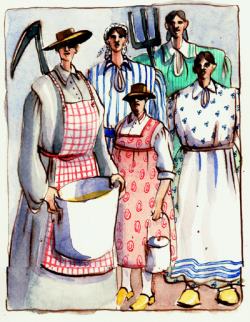
The Parshah of Bamidbar (Numbers 1:1–4:20) begins with a census of the Jewish people.
“. . . a head-count of every male according to the number of their names. From twenty years old and upwards, all who are fit to go out to the army in Israel, you shall count them by their legions . . .”
The simple reason for this census was to count those who would be called upon to go to war.
On a deeper level, our sages explains that G‑d desired a census of the Jewish people because He treasures them.1The masculine force in creation is outward-bound, while the feminine is inward-bound
The chassidic masters explain that the counting of the Jewish people demonstrated the value of every single individual, how cherished each one is to G‑d. Each person was counted, irrespective of his level of observance, his aptitude or skills, his degree of learnedness, or whether he was a man of means or impoverished. Each individual was shown that he counted for no more and no less than one. Irrespective of external trappings, he was shown that G‑d treasures his essential value. Moreover, by accentuating his independent identity, he was empowered to respect his own individuality and remain true to himself.2
However, on this level, it becomes questionable why a large segment of the Jewish people was entirely excluded. Only the males were counted, and only those from twenty and upwards. Are some perhaps more equal than others? Was the contribution of the entire female population not cherished by G‑d?
The Kabbalists explain that the masculine force in creation is outward-bound, while the feminine is inward-bound. The spiritual service of man is to forge into the outside, foreign territory, to wage war against the negativity of our world. The spiritual role of the woman, by contrast, is to protect, nurture, discover and reveal the holiness implicit in creation.
We are in a male mode when we go outside of ourselves in order to impose a higher truth upon our world and ourselves. When we seek to nurture the divine power in what already is, and become sensitized to the potential of our inner essence, we are using our feminine dynamic.
The counting of the Jewish people began from the age of twenty and upwards, those who were mature enough physically, emotionally and spiritually to go out to wage war.3
What is “going out to war” in the spiritual sense?
Our task as human beings is to create a world that is a home for our Creator, compatible to His standards and morals, a holy world.
We can accomplish this through two modalities.
On the one hand, we bring more G‑dliness into our world by fighting against the darkness and evil around us. We vanquish the earthly negativity by aggressively assaulting it—through physical might, by literally waging war against the tyranny of cruel regimes, or through ideological battles against immoral ideals.
The other modality is to strengthen, cultivate and nurture the positive already inherent in G‑d’s creation. This mode is not waging a war or imposing an order, but rather uncovering and nurturing the positive and G‑dly aspects within our world, and thereby increasing and spreading holiness.
While the first mode means putting oneself in a position of danger by exposing oneself to the outside elements, the second involves protecting and guarding the precious inner elements of G‑dliness within our lives and our world.
Both of these approaches are necessary, and each role is integral to the Creator’s plan. There are times when we must wage an external battle, and there are times when we must safeguard our internal treasures.
While the protection-and-discovery mode requires delicate skills and spiritual sensitivity, waging an external battle involves definite risk and exposure. To battle against outside forces, one must have not only adequate training, but also a strong sense of identity and a real appreciation for one’s uniqueness and worth as an individual.
The census in this Torah portion was for those individuals who were given the task of “going out” and “waging war.” The men fighting on the outside needed this infusion much more than the women, whose focus was inward. When on the attack, fighting in alien environments against foreign values which constantly attempt to erode one’s ideals and vision, this reminder was needed to keep the warrior focused and on track instead of swallowed up by the surrounding norms.4G‑d provides extra empowerment to those who are exposed and vulnerable
Perhaps this is the reason for why only the men were counted. G‑d provides extra empowerment to those who are exposed and vulnerable in waging battle against the negative forces of creation, not needing to provide this to the women, whose self-worth is constantly being validated through their role of safeguarding our inner treasures.
This is not to imply that the woman’s task is “easier” or requires less of them. On the contrary, their role was, and is, critical. But their challenges are different ones, and women don’t need this enforcement of their worth.
Their inner worth, which they guarded so preciously for themselves and for their families, was obvious to them and was never challenged.
FOOTNOTES
1. Midrash Rabbah, Bamidbar 1:4; Rashi on Numbers 1:1.
2. The empowering effect of numbering is reflected in the halachic rule that “an entity which is counted can never be nullified” (Talmud, Beitzah 3b; Shulchan Aruch, Yoreh De’ah 110:1). Under certain circumstances, certain food items are “nullified” when mixed with a quantity sixty times their volume. For example, if some milk drops fall into a meat soup, the entire mixture becomes forbidden. If, however, the volume of the meat mixture is sixty times that of the milk, then the milk is considered nullified and nonexistent. However, an object that is sold solely by unit is considered “prominent” and cannot be nullified. An example of this is: if whole eggs of a non-kosher bird become mixed with kosher eggs, it is not batel b’rov—“nullified by the majority”—since eggs are sold by count (e.g., by the dozen) rather than by weight or volume.
3. See Ethics of the Fathers 5:22, which states: “At five years of age, the study of Scripture (should be commenced); at ten, the study of Mishnah; at thirteen, the mitzvot; at fifteen, the study of Talmud; at eighteen, marriage; at twenty, pursuit of livelihood . . .” Up until the age of twenty, the individual’s focus is primarily on himself and his own personal growth. Only at the age of twenty does he turn outwards and go out into the world, to make a living.
4. This is similar to the requirement for men to wear a yarmulke (skullcap) on their heads as a constant reminder of G‑d’s presence. Being the ones who assume this “outer” role, where their beliefs and ideology are undermined, men need the constant “reminder” about G‑d’s presence.
• Learn the Parshah In Depth
Parshat Bamidbar In-Depth
Numbers 1:1-4:20
Parshah Summary
In the desert (“bamidbar”) of Sinai, on the first of the month of Iyar, one year and two weeks after the exodus from Egypt, G‑d speaks to Moses. The leader of Israel is instructed to conduct a census of his people:
Raise the head of all the congregation of the children of Israel, by families following their fathers’ houses; a headcount of every male according to the number of their names.
From twenty years old and upwards, all that are fit to go out to the army in Israel, you shall count them by their legions, you and Aaron.
Assisting Moses and Aaron are the leaders of the twelve tribes of Israel. The people assemble and “declare their pedigrees after their families, after the house of their fathers.” The results of the census are:
The tribe of Reuben—46,500; Simeon—59,300; Gad—45,650; Judah—74,600; Issachar—54,400; Zebulun—57,400; Ephraim—40,500; Manasseh—32,200; Benjamin—35,400; Dan—62,700; Asher—41,500; Naphtali—53,400.
All those who were counted of the children of Israel . . . six hundred and three thousand, five hundred and fifty.
The Levites
The tribe of Levi, however, was not included in this count, for they are to be “set aside,” consecrated to serve in the Sanctuary. As G‑d instructs Moses:
Only you shall not count the tribe of Levi, nor take the sum of them among the children of Israel.
Appoint the Levites over the Tabernacle of Testimony, and over all its vessels, and over all things that belong to it. They shall carry the Tabernacle and all its vessels, they shall minister to it, and round about the Tabernacle shall they camp.
And when the Tabernacle journeys forward, the Levites shall take it down, and when the Tabernacle is to be pitched, the Levites shall set it up.
The Camp
“Every man by his flag shall the children of Israel camp.” Each of the twelve tribes had its nassi (“prince”), a flag representing its color and emblem, and its own section in the Israelite camp.
The Sanctuary stood in the center of the camp, surrounded by the tents of the Levites. Beyond the Levite camp were the camps of the twelve tribes. To the east were the tribes of Judah, Issachar and Zebulun, together comprising the greater “Camp of Judah.” To the south was the “Camp of Reuben,” encompassing the camps of Reuben, Simeon and Gad. To the west, Ephraim, Manasseh and Benjamin made up the “Camp of Ephraim.” To the north was the “Camp of Dan” with Dan, Asher and Naphtali.
This formation was preserved as the people journeyed through the desert, with the Camp of Judah at the head of the procession and the Camp of Dan bringing up the rear.
Again the Torah lists the adult male population for each tribe, also tallying the total for each camp: 186,400 for the Camp of Judah, 151,450 for the Camp of Reuben, 108,100 in the Camp of Ephraim, and 157,600 for the three tribes comprising the Camp of Dan. Total: 603,550.
“The Levites were not counted together with the children of Israel, as G‑d had commanded to Moses.”
The Levite Census
Originally, the service in the Sanctuary was to have been performed by the firstborn, since “on the day that I smote all firstborn in Egypt, I have consecrated to Me all firstborn in Israel.” But this privilege was taken from them when the firstborn joined in the making of the golden calf, and only the tribe of Levi remained loyal to G‑d (cf. Exodus 32:26).
G‑d now commands Moses to count the Levites, in order to appoint them to their specific tasks in the service of the Sanctuary. It was also necessary to know their exact number, so that a transfer of the “consecration” could be made from each of the firstborn to the individual Levite who would replace him. Unlike the other tribes, the census of the Levites included children as well, beginning from the age of one month.
First to be enumerated is Aaron’s family, who constituted a distinct class within the Levite tribe: they were the kohanim (“priests”), who conducted the service in the Sanctuary.
These are the generations of Aaron and Moses in the day that G‑d spoke with Moses on Mount Sinai. And these are the names of the sons of Aaron: the firstborn Nadav, Avihu, Elazar and Itamar . . .
Nadav and Avihu died before G‑d, when they offered strange fire before G‑d in the wilderness of Sinai, and they had no children; and Elazar and Itamar ministered in the priest’s office in the sight of Aaron their father.
The rest of the tribe of Levi served as assistants to the kohanim and as caretakers of the Sanctuary, and were divided into three clans, descendants of Levi’s three sons: Gershon, Kohath and Merari.
The Gershonites numbered 7,500, and camped on the west side of the Sanctuary. When the Sanctuary was transported, the families of Gershon were in charge of “the Tabernacle roof-covering, and the tent roof-covering, the upper roof-covering, and the screen for the entrance to the Tent of Meeting; the hangings of the courtyard, the screen at the entrance to the courtyard . . . its ropes, as well as all the work involved.”
The families of Kohath, numbering 8,600 and pitching their tents to the Sanctuary’s south, carried the Sanctuary’s “vessels”: “The ark, the table, the menorah, the altars and the holy vessels with which the service is performed; and the [inner] screen and all its implements.”
The Merari families totaled 6,200, and camped to the Sanctuary’s north. “Under the custody and charge of the sons of Merari shall be the wall-panels of the Tabernacle, its bars, its pillars, its foundation sockets, and all their implements and all that belongs to them, and the pillars of the court round about, and their sockets, pegs and cords.”
Camping before the Tabernacle toward the east, before the Tent of Meeting eastward, shall be Moses and Aaron and his sons, keeping the charge of the sanctuary for the charge of the children of Israel.
G‑d now commands Moses to count all male firstborn in Israel from the age of one month and older, and “take the Levites to Me—I am G‑d—in the place of all the firstborn of Israel.”
There were 22,273 firstborns, but only 22,000 Levites to replace them. The remaining 273 each contributed a sum of five shekels to Aaron and his sons as a “ransom.” (All subsequently firstborn Israelite males are likewise redeemed.)
Covering the Vessels
When the Levites transported the Sanctuary, the most prestigious task fell to the Kohathites: on their shoulders they carried the Sanctuary’s holy vessels. But first the vessels had to be covered by the priests with special wool and leather coverings made for this purpose.
When the camp is about to travel, Aaron and his sons shall come and take down the dividing screen; with it, they shall cover the Ark of Testimony. They shall place upon it a covering of tachash skin, and on top of that they shall spread a cloth of pure blue wool. Then they shall put its poles in place.
Similar coverings were made for the table, the menorah and the two altars, to “swallow the holy” and conceal them from non-priestly eyes.
From Our Sages
G‑d spoke to Moses in the desert of Sinai (Numbers 1:1)
The Torah was given to the people of Israel in the ownerless desert. For if it were given in the Land of Israel, the residents of the Land of Israel would say, “It is ours”; and if it were given in some other place, the residents of that place would say, “It is ours.” Therefore it was given in the wilderness, so that anyone who wishes to acquire it may acquire it.
(Mechilta d’Rashbi)
Why was the Torah given in the desert? To teach us that if a person does not surrender himself to it like the desert, he cannot merit the words of Torah. And to teach us that just as the desert is endless, so is the Torah without end.
(Pesikta d’Rav Kahana)
It is customary that on the Shabbat before a wedding, the bridegroom is called to the Torah. Shavuot, the festival which coincides with the anniversary of the giving of the Torah at Mount Sinai, represents the marriage of G‑d and Israel; this is why the Torah portion of Bamidbar (“in the desert”) is usually read on the Shabbat before Shavuot.
(Rabbi Yosef Yitzchak of Lubavitch)
G‑d spoke to Moses in the desert of Sinai (1:1)
By three things was the Torah given: by fire, water and desert. By fire, as it is written (Exodus 19:18): “Now Mount Sinai was altogether on smoke, because G-d descended upon it in fire.” By water, as it is written (Judges 4:4): “The heavens also dripped, yea, the clouds dripped water.” And by desert, as it is written (Numbers 1:1): “G‑d spoke to Moses in the desert of Sinai.”
(Midrash Rabbah)
Fire, water and desert—by these we established our commitment to the Torah.
The first Jew, Abraham, was cast into a fiery furnace for his loyalty to the way of G‑d. And lest one say that this was an extraordinary act by an extraordinary individual, at the shores of the Red Sea an entire people plunged into the sea’s waters when the divine command to “move forward!” issued forth. And lest one say that this was a spur-of-the-moment heroism, for forty years the people of Israel followed G‑d through the barren, hostile desert, trusting in Him to provide for them and protect them. As the prophet Jeremiah declaims, “I remember the kindness of your youth, your bridal love, your following after Me in the desert, in an unsown land.”
(Rabbi Meir Shapira of Lublin)
Raise the head of all the congregation of the children of Israel . . . by the number of names (1:2)
On ten occasions were Israel counted. Once when they went down to Egypt (Genesis 46). A second time when they came out (Exodus 12:37). A third time after the incident of the golden calf (ibid., 30:12). Twice in the Book of Numbers: once in the formation of the camps (Numbers 1) and once in connection with the division of the Land (ibid. 26). Twice in the days of Saul (I Samuel 11:8 and 15:4). The eighth time in the days of David (II Samuel 24:9). The ninth time they were numbered was in the days of Ezra (Ezra 2:64; Nehemiah 7:66). The tenth time will be in the future era of Moshiach, when “the flocks shall again pass under the hands of Him that counts them” (Jeremiah 33:13).
(Midrash Rabbah)
Because of G‑d’s great love for His people, He counts them all the time. He counted them when they left Egypt. He counted them after they fell in the wake of the sin of the golden calf, to know the number of the survivors. And He counted them when He came to manifest His presence within them: on the first of Nissan the Sanctuary was erected, and [one month later] on the first of Iyar He counted them.
(Rashi)
This is reflected in the Hebrew word for “count,” pakod, which also means to “remember” and “be concerned with.”
(Nachmanides)
A census expresses two paradoxical truths. On the one hand, it implies that each individual is significant. On the other hand, a headcount is the ultimate equalizer: each member of the community, from the greatest to the lowliest, counts for no less and no more than “one.” G‑d repeatedly commands Moses to count the Jewish people to emphasize both their individual worth—the fact that no single person’s contribution is dispensable—as well as their inherent equality.
(The Chassidic Masters)
From the age of twenty and upward, all who are fit to serve in the army of Israel, you shall count them (1:3)
Moses’ census of the Jewish people, defined as a count of “all who are fit to serve in the army of Israel,” included only those who were “from the age of twenty and upwards.” What is the significance of this requirement?
The fifth chapter of Ethics of the Fathers includes an outline of the phases of a person’s education and life: “At five years of age, the study of Scripture; at ten, the study of Mishnah; at thirteen, the obligation to observe the mitzvot; at fifteen, the study of Talmud; at eighteen, marriage; at twenty begins the pursuit [of a livelihood]; at thirty, one attains strength; at forty, understanding; at fifty, one can give counsel . . .”
In other words, the first twenty years of a person’s life represent those periods and areas of his life in which he focuses almost exclusively on his individual growth: the acquisition of knowledge and wisdom, and his moral and spiritual development. “Twenty” represents the point at which he ventures out to the world and begins to concern himself with the material involvements of life.
Therein lies the deeper significance of G‑d’s instruction to Moses that only “from the age of twenty and upwards” shall a person be counted as one “fit to serve in the army of Israel.”
A period of intense self-development and spiritual self-enrichment is a necessary preparation to life, but it must not be seen as an end in itself. The purpose of the “pre-twenty” times and aspects of a person’s life is for the sake of the “pursuit” which must follow: that he or she go out into the world and apply his personal attainments to the development and sanctification of the material reality. One who does not graduate to the “post-twenty” phase of life cannot count himself as a member of the “army of Israel.”
(The Lubavitcher Rebbe)
Every man by his flag shall the children of Israel camp (2:2)
Each tribe had its own prince, and its flag, whose color corresponded to the color of its stone [in Aaron’s breastplate—see Exodus 28:15–21]. It was from the tribes of Israel that kingdoms learned to provide themselves with flags of various colors.
Reuben’s stone was a ruby; the color of his flag was red, and embroidered thereon were mandrakes [cf. Genesis 30:14].
Simeon’s stone was a topaz; his flag was of a green color, and the town of Shechem was embroidered thereon [cf. Genesis 34:25].
Levi’s stone was a smaragd; the color of his flag was one-third white, one third black and one third red, and embroidered thereon was [Aaron’s breastplate with] the Urim and Tummim.
Judah’s stone was a carbuncle; the color of his flag was like the color of the heavens, and embroidered on it was a lion [cf. Genesis 49:9].
Issachar’s stone was a sapphire; the color of his flag was black like stibnite, and embroidered thereon were the sun and moon, in allusion to the verse “Of the children of Issachar, men that had understanding of the times” (I Chronicles 12:33).
Zebulun’s stone was an emerald; the color of his flag was white, with a ship embroidered thereon, in allusion to the verse “Zebulun shall dwell at the shore of the sea” (Genesis 49:13).
Dan’s stone was a jacinth; the color of his flag was similar to sapphire, and embroidered on it was a serpent, in allusion to the verse “Dan shall be a serpent in the way” (ibid. v. 17).
Gad’s stone was an agate; the color of his flag was neither white nor black but a blend of black and white, and on it was embroidered a military camp, in allusion to the verse “Gad, a troop shall troop upon him” (ibid. v. 19).
Naphtali’s stone was an amethyst; the color of his flag was like clarified wine of a light red, and on it was embroidered a deer, in allusion to the verse “Naphtali is a deer let loose” (ibid. v. 21).
Asher’s stone was a beryl; the color of his flag was like the precious stone with which women adorn themselves, and embroidered thereon was an olive tree, in allusion to the verse “As for Asher, his bread shall be fat with oil” (ibid. v. 20).
Joseph’s stone was an onyx, and the color of his flags was jet black; the embroidered design thereon for the two tribes descending from Joseph, Ephraim and Manasseh, was Egypt, because they were born in Egypt. On the flag of Ephraim was embroidered a bullock, in allusion to the verse “His firstling bullock” (Deuteronomy 33:17), which refers to Joshua, who came from the tribe of Ephraim. On the flag of the tribe of Manasseh was embroidered a unicorn, in allusion to the verse “And his horns are the horns of the re’em” (ibid.), which alludes to Gideon son of Joash, who came from the tribe of Menasseh.
Benjamin’s stone was jasper, and the color of his flag was a combination of all the twelve colors; embroidered thereon was a wolf, in allusion to the verse “Benjamin is a wolf that preys” (Genesis 49:27).
(Midrash Rabbah)
The children of Israel shall encamp each man by his division, by the ensigns of their fathers’ house (2:2)
What is the meaning of “by the ensigns of their father’s house”?
When G‑d told Moses to organize the Israelite camp, Moses began to feel distressed. He thought, “Now strife will arise among the tribes; for if I tell the tribe of Judah to camp on the east side of the Tabernacle, and he says, ‘I will accept only the south,’ and the same applies to Reuben and the same to Ephraim and to each of the other tribes, what am I to do?”
Said G‑d to him: “Moses, why should that trouble you? They have no need of you. They know their places full well themselves. They are in possession of a testament left them by Jacob their father, which tells them how to camp under their standards. In the same way that they disposed themselves round his bier when they carried him, so shall they dispose themselves round the Tabernacle. I am not going to make any changes.”
For Rav Chama, son of Rabbi Chanina, said: When our father Jacob was about to depart from the world, he summoned his sons and he blessed them and commanded them concerning the ways of G‑d, and they acknowledged the divine sovereignty. Having concluded his address, he said to them: “My children, when my bier is being carried, Judah, Issachar and Zebulun shall be on the east side; Reuben, Simeon and Gad shall be on the south side; Ephraim, Manasseh and Benjamin shall be on the west side; Dan, Asher and Naphtali shall be on the north side; Joseph shall not carry at all, for he is a king and must be shown due honor; neither shall Levi carry, because he will carry the Ark, and he that is to carry the Ark of Him who is the life of all worlds must not carry the coffin of the dead. If you will comply with these orders and carry my bier as I have commanded you, G‑d will in the future cause you to camp beneath standards.”
(Midrash Rabbah)
These are the generations of Aaron and Moses . . . Nadav, Avihu, Elazar and Itamar (3:1–2)
He who teaches the son of his fellow the Torah, Scripture ascribes it to him as if he had begotten him, as it says: “These are the generations of Aaron and Moses”—and only the sons of Aaron are listed. Aaron begot them and Moses taught them, and they are called by Moses’ name.
(Talmud, Sanhedrin 19b)
These are the generations of Aaron and Moses . . . Nadav, Avihu, Elazar and Itamar (3:1–2)
Why did Moses’ sons not merit [to be in the leadership of Israel]? Because they did not experience the exodus from Egypt and did not traverse the sea with the people of Israel, as they were [in Midian] with Jethro (Moses’ father-in-law—see Exodus 18:1–6).
(Midrash HaChefetz)
These are the generations of Aaron and Moses (3:1–2)
Usually Moses appears before Aaron, but in certain places Aaron is mentioned first. This is to teach us that they were both of equal importance.
(Midrash)
Behold, I have taken the Levites from amongst the children of Israel . . . and the Levites shall be Mine (3:12)
Not only the tribe of Levi, but any man of all the inhabitants of the earth whose spirit has moved him and whose mind has given him to understand to set himself aside to stand before G‑d to serve Him, to worship Him, to know G‑d and walk justly as G‑d has created him [justly], and he cast from his neck the yoke of the many calculations that men seek—this man has become sanctified, a holy of holies, and G‑d shall be his portion and his lot forever, and shall merit him his needs in this world, as He has merited the kohanim and the Levites.
(Maimonides)
All that were numbered of the Levites . . . were twenty-two thousand (3:39)
The tribe of Levi was different from all the others: even counting all members from the age of one month, there were only 22,000; when those thirty years or older were counted, they totaled 8,000 (see Numbers 4:48). Hence, if we were to estimate their members from age twenty, they would not be half the number of the least populous of the other tribes!
It seems to me that this verifies that which our sages said, that the tribe of Levi was not subjected to slave labor in Egypt. G‑d greatly increased the numbers of the Israelites whose lives were made bitter by the Egyptians with hard labor in order to decimate them, in order to counteract the Egyptians’ decrees, as it is written (Exodus 1:12): “As they afflicted them, so did they increase, and so did they grow strong.” The tribe of Levi, however, increased only at the natural rate . . .
(Nachmanides)
For the redemption of those 273 of the firstborn of the children of Israel who are more than the Levites, you shall take five shekels for every man (3:46–47)
In fact, [if we add up the counts of each of the clans, we can see that] there were 22,300 Levites: 7,500 Gershonites, 8,600 Kohathites and 6,200 Merarites—total 22,300, [300 more than listed in the total given for all the Levites.] So why were these not included with the rest in the redemption of the firstborn, so that the extra 273 should not require redemption? Our sages explained that these 300 were themselves firstborn, and had to “redeem” themselves.
(Rashi; Talmud)
Said Moses: How shall I act toward Israel? If I say to a man, “Give me [the shekels for] your redemption,” he will say: “A Levite has already redeemed me.”
What did Moses do? He brought twenty-two thousand slips and wrote on each “Levite,” and on another two hundred and seventy-three he wrote “five shekels.” Then he mixed them up, put them into an urn and said to the people, “Draw your slips.” To each who drew a slip bearing the word “Levite,” he said, “A Levite has redeemed you.” To each who drew a ticket with “five shekels” on it, he said, “Pay your redemption and go.”
(Talmud, Sanhedrin 17a)
When the camp journeys on, Aaron and his sons shall come and take down the dividing curtain [of the Sanctuary] and cover the Ark of Testimony with it. They shall place upon it a covering of tachash hide, and spread over it a garment wholly of blue wool (4:5–6)
Like the Ark, the soul of man is encased within three coverings: 1) it is overlaid with a selfish and materialistic character (what Chassidism calls “the animal soul”); 2) it is embedded within a physical body; 3) it is placed in a physical world which obscures and distorts the divine reality.
As long as the Ark stood in its place in the Holy of Holies, it had no need for coverings. But when the time came for it to journey on, G‑d commanded that it be “swallowed up” by its threefold vestment. The same applies to the soul. A “spark of G‑dliness,” the soul is perfect and complete unto itself. But to journey on—to advance further in the infinite journey toward union with its Infinite Source—it must undergo on a “descent for the sake of ascent.” It must be subjected to the threefold concealment of human nature, physicality and worldliness, to discover in the lowliest reaches of creation the key for even greater connection with G‑d.
(The Lubavitcher Rebbe)
EDITOR'S PICKS

The Kabbalah of Making Money
We human beings have a knack at seeing how the parts of this world fit back together. By Tzvi FreemanHow do you make money?
As any successful businessperson will tell you, it’s all about connections. You put things together. Or people together. Or people and things together. And somehow, you’ve created more value in the world. Since you created it, you get a chunk of that value, often in the form of money.
Pretty neat, isn’t it? Something out of nothing. Now, how does that work?
It works because at its origin, our entire world is one big thought. Not just a mass. Or an energy field. But a thought. That thought was too great for any universe to contain, so it exploded into countless scattered parts that comprise the world in which we live.
We human beings come to the world with a faint memory of that primordial thought. That’s why we have a knack for seeing how those parts fit back together. When they do fit together, the world gets closer to that original thought—and that’s why more value appears.
That’s why any business that creates real value is a divine calling—because it’s fixing up the world. And that’s why we see that honest, value-based business is responsible—more than any other venture—for increasing peace, health, education, comfort and general wellbeing throughout the world.
There’s another step after these pieces are put together: We have to find deeper meaning in those value-creating ventures. We also have to use the money we create and the opportunities afforded us for higher purposes. Acts of kindness and compassion, wisdom and meaning. That way we draw out the light our world holds deep inside—the light of that primordial thought.
That original thought exploded by design. The universe was never meant to be a top-down job. The thought was only the beginning—its fulfillment lies in our hands. Because the only receptacle for divine light, our sages say, is harmony and peace—and that can be created only from the bottom up. It’s only when we citizens of this universe do the work, putting the pieces together ourselves, that our world can contain even an infinite light.
And that’s just around the corner right now.More in Editor's Picks:
• Q&A: At Ease! Pioneering Jewish Army Chaplain Retires After Nearly 40 Years - Rabbi Jacob Goldstein, the highest-ranking Jewish chaplain for decades, will soldier on (By Menachem Posner)
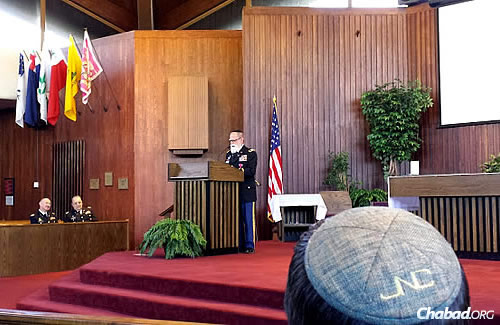
Rabbi Jacob Goldstein recently retired amid pomp and circumstance at a ceremony in Fort Myer, Va.
Thirty-eight years ago, Rabbi Jacob Goldstein enlisted in the U.S. Army as a chaplain. After serving with distinction as the highest-ranking Jewish chaplain for decades, he recently retired amid pomp and circumstance in Fort Myer, Va. While the ceremony is normally reserved for those on active duty, the chief chaplain made sure that Col. Goldstein was included in the proceedings. On his way back home to Brooklyn, N.Y., he shared some highlights of his colorful and very necessary career.
Q: Nearly 40 years in the army is a very long time. Did you plan on doing this for so long?
A: Never in my wildest dreams did I imagine that I would serve for so long—nor did I ever see myself in the military in the first place.


Q: Why did you choose that particular branch of the military?
A: Because Army is the best, of course. In all seriousness, it began in 1967 when theRebbe—Rabbi Menachem M. Schneerson, of righteous memory—initiated the tefillincampaign. I began visiting a military base and putting on tefillin with the Jewish fellows. This continued after I got married in 1969.
At one point, a chaplain—a Roman Catholic priest—asked for the address of my bishop so he could request that I enlist. He didn’t end up writing to the Rebbe, but I consulted with the Rebbe, and the rest is history.
Q: How involved was the Rebbe in your career?
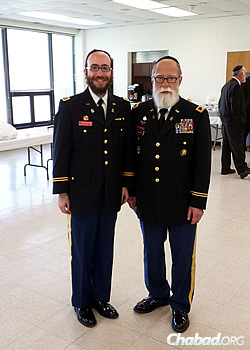
Goldstein with his nephew, Rabbi Maj. Chesky Tenenbaum, a chaplain in Maryland's state militia
A: I would say that I never made a major decision without the Rebbe’s knowledge and guidance.
There were times when he would give me very specific missions. For example, in 1983, I was in Grenada over Chanukah. The Rebbe requested that I inquire about the welfare of the Jewish residents of the island, make an effort to lay tefillin on every Jewish soldier and, if possible, give Chanukah gelt (monetary gifts) to the soldiers. I was also tasked with printing a Tanya there.
And then there was the well-known example of how the Rebbe predicted what would happen to me during the first Gulf war in 1991.
[Iraqi President] Saddam Hussein was threatening to bomb Israel, and there was talk of Jews being gassed in Israel. My mother, who lived in New York, was a Holocaust survivor, and she was very agitated. I had just gotten mobilized and decided to bring her to the Rebbe to see if he could calm her down. Before she could say a word, the Rebbe told her that there was nothing to worry about; Israel would be safe.
Then, the night before I was called up, I went to the Rebbe again. I had been called up for a whole year and was supposed to go to Saudi Arabia. It was just before Chanukah. Thinking ahead, I told the Rebbe that I was taking along aMegillah to read on Purim. The Rebbe told me: “A Megillah will be there, and you will not need to read it.” And he gave me a blessing. I had no idea what that meant. How would there be a Megillah in Saudi Arabia, and who would possibly be able to read it there besides me?
The next morning, I was told that I had been reassigned to Israel.
At a later point my father-in-law, the late Rabbi Dovid Edelman, asked the Rebbe that I return home soon. The Rebbe looked at him and said: “What is the rush? He’s bringing the Sons of Noah close [to G‑d]!”
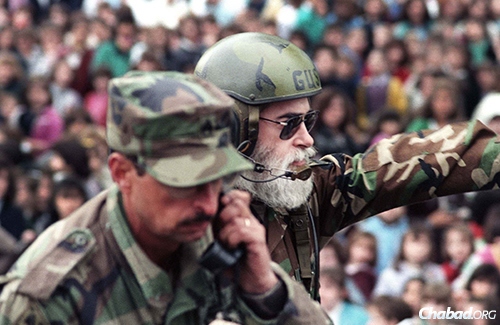
Goldstein enlisted in the U.S. Army as a chaplain 38 years ago, serving with distinction as the highest-ranking Jewish chaplain for decades. Here, he drives by at the Lag BaOmer parade on May 13, 1990 (5750) in the Crown Heights neighborhood of Brooklyn, N.Y. (JEM Photo)
Q: Looking back, what are some accomplishments that you would single out?
A: When I originally enlisted, I had quite a difficult time because of my refusal to shave my beard. Thank G‑d, we’ve overcome that challenge, and there are a number of bearded chaplains, including Rabbi Menachem Stern, who’s on active duty.
Beyond that, another thing that comes to mind is that we now have kosherMREs (“meals ready to eat”) for Jewish servicemen and women.
And there are the many people whose lives a chaplain touches in ways you can only imagine.
Q: Can you share an example?
A: This takes us back to “Operation Iraqi Freedom,” when I was in Iraq in 2003. I was going through Basra, which is hot, very hot, and uncomfortable. In Camp Bucca—a huge prison for Iraqi prisoners of war—there were Jewish military police, and I had gone to visit them. In the morning, we gathered together aminyan of guys and began services. All of the sudden, a Jewish female soldier showed up and wanted to participate. We were outside in the desert, with no walls or anything that could possibly serve to separate males and females ashalachah (Jewish law) requires. I was at a loss for a moment. Then I asked my assistant to go to the ammo dump and bring back a load of artillery shells. We took the shells and fashioned a mechitzah (partition), and she was able to join the services.
Today, that woman recently retired from the military and is a fully observant Jew. Her children live in Israel, and she plans to join them there. She told me that she knew nothing about Judaism when she showed up that morning in Basra, and it was the determination to include her that changed her life. We made it our business to make her feel welcome, and that opened the door for her family’s entrance to Jewish observance.
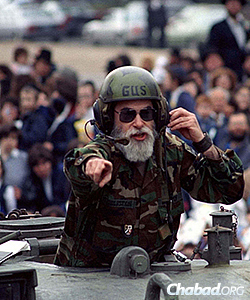
Goldstein acknowledges the the Lubavitcher Rebbe—Rabbi Menachem M. Schneerson, of righteous memory—at the parade. (JEM Photo)
Q: After such an involved and fulfilling career, why did you remain in the reserves, not enlisting for active duty?
A: After my service in Grenada, the Grand General asked the Rebbe the same thing (there was correspondence between them, as the Rebbe thanked him for facilitating the publishing of the Tanya there). The Rebbe replied that my parents were elderly Holocaust survivors, and they needed me close by. From that I understood that my mission was to be near my parents—something I did until my mother passed away two years ago.
Q: Is there a specific assignment that you would say is most memorable?
A: Every one is different. Each experience is different. Some are more dangerous, and others were touching in other ways. I was in Bosnia, which touched me in one way, and then I went to the U.S. South after Hurricane Katrina and oversaw 200 chaplains there, which was a whole different world. Then there was 9/11 and “Ground Zero,” where I was the chief chaplain, impacting people in a whole different way. Each mission was unique, and each was significant at that time.
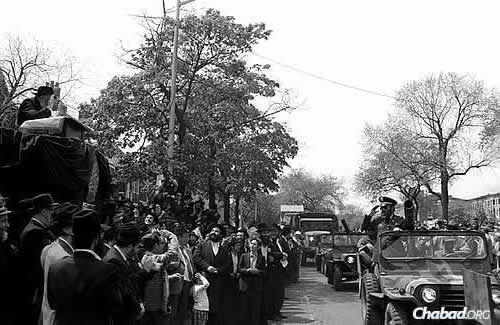
Lag BaOmer 5740: The grand parade in Crown Heights on Sunday, May 4, 1980. (JEM Photo)
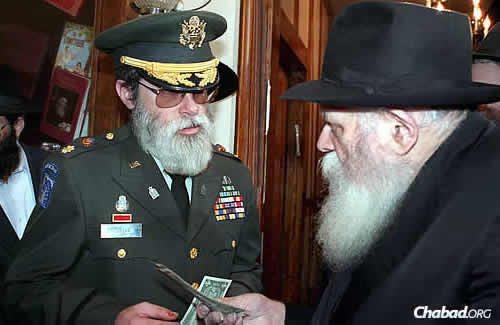
Getting a dollar from the Rebbe in December 1990, shortly before the first Gulf war. (JEM Photo)
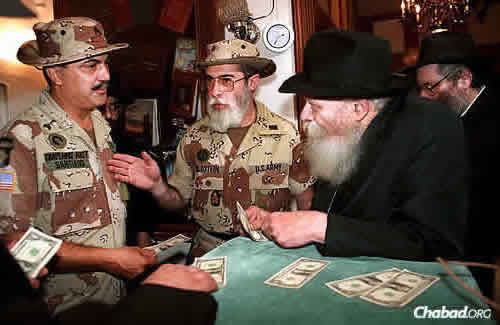
With the Rebbe in September 1991 (JEM Photo)
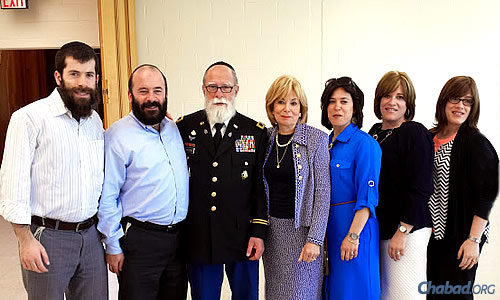
Goldstein and members of his family at the April 29 ceremony
LIFESTYLE

Bake: Lemon Raspberry Cheesecake By Miriam SzokovskiI’ve finally conquered one of my food fears—cheesecake. I’ve made lots ofno-bake cheesecakes, and other dairy desserts, but for some reason, until now I’ve held back from tackling the traditional baked variety. Finally, today I present you my deliciously pink Raspberry-Swirled Lemon Cheesecake.

Why cheesecake? The holiday of Shavuot is almost upon us, when we celebrate the giving of the Torah by hearing the Ten Commandments being read in the synagogue. Some of the customs specific to this holiday includedecorating our homes with greenery and eating dairy food.
This cheesecake is less heavy, rich and sweet than the many caramel- and chocolate-laden cheesecakes out there. The lemon and raspberry give it a distinct tartness.

It’s also relatively easy to make, and doesn’t require any specialty ingredients.
Simply make and bake the crust.

Pour in the filling.

Spoon the raspberry mixture over the top.

Swirl it with a knife.

Bake it and refrigerate overnight.

Cut into squares and serve.

Crust Ingredients:
8 graham crackers
4 tbsp. butter
2 tbsp. brown sugar
½ tsp. salt
Crust Directions:
Roughly pulse the graham crackers in a food processor a couple of times. Cut the butter into small pieces and add it in along with the sugar. Pulse until mixture resembles a course crumb.
Tip the graham cracker mixture into an 8″ × 11″ tart pan with a removable base and press down firmly. Bake at 325° F for 10 minutes. Set aside to cool.
Filling Ingredients:
16 oz. cream cheese
¾ cup sugar
2 eggs
2 lemons
Filling Directions:
Let the cream cheese come to room temperature.
Juice the lemons.
Beat the cream cheese until smooth. Add in the sugar, eggs and lemon juice and mix until smooth.
Pour the mixture into the pie crust.
Raspberry Swirl Ingredients:
1 cup raspberries
3 tbsp. sugar
Swirl Directions:
Wash and check the raspberries.
Place them in a shallow bowl, or on a plate, and sprinkle with sugar. Let the raspberries and sugar sit for about 30 minutes to draw out the juices, then blend.
Strain the mixture through a fine-mesh sieve.
Spoon the raspberry mixture over the cheese mixture. Swirl with a knife.
Bake at 325° F for 35 minutes.
Refrigerate overnight, cut into squares and serve.
Yields: 15–18 squares
Do you like cheesecake? Bake it often? Leave your best cheesecake tips in the comment section below, so we can all be well equipped for our Shavuotbaking!

Don’t like cheesecake? Try some of these dairy dessert alternatives: Maple Pumpkin Pie Ice Cream with Pecan Crunch Topping, Macerated Strawberry Ice Cream, Vanilla Ice Cream with Cinnamon and Chocolate Bits or Layered No-Bake Cheesecake Cups. Or, if you prefer non-dairy, try this Cheeseless Cheesecake or my striking Mount Sinai Cake.
Of course, we have plenty of savory Shavuot recipes for you, too.
Happy Shavuot!
More in Lifestyle:
• Craft: Decorative Flower Garland
I love decorating my home with flowers for Shavuot. It reminds us of when G‑dgave us the Torah on beautiful Mount Sinai, which He lavishly decorated with flowers. I usually fill all the vases with my favorite picks and place the vases all over my home. This year, I wanted to do something different, and I decided the tissue paper garlands that I see everywhere could be easily adapted for the holiday.• Craft: Decorative Flower Garland

You will need:
Tissue paper in your favorite colors
Scissors
Hot glue gun
Glue stick
Twine or ribbon
Flower Instructions:

Open your packages of tissue paper and lay the sheets flat in a stack.
Cut a square from the stack, about 6″ × 6″ (the size does not have to be exact). Make sure to cut through the entire stack so your square is about 10 pieces thick.
Fold the square stack in half. Fold it again till you have a small 2″ square.
Cut three petals from the mini-square from the open edges. Don’t cut on the folds. This does not have to be perfect. Once you have cut your petals, open up the flower and pull the pieces apart.
Now it’s time to create your flower. Take the petal layers and stack them, one by one, using the glue stick to attach each layer. Make sure to turn each layer so the petals do not line up. This gives it a more authentic flower look. Set your flowers aside to dry.
Tassel Instructions:
Take one piece of tissue paper and fold it along the lines from the packaging—i.e., fold it once along the width and in half along the length. You should have a rectangle.
Hold it lengthwise and trim a fringe along the bottom of the rectangle, leaving about 2 inches on top. Open the paper up again and cut it in half all the way down the fold line, so you have two pieces like in the picture.
Take one piece and twist the flat part in the middle of the tissue until it’s tight. Turn the twist, making a loop, and use the glue gun to hold the loop together. You should now have a tassel.
To Assemble:
Attach the flowers to your twine or ribbon with the hot glue gun, and string your tassels through the loop. Use your creative eye to design a pattern combo you like.
Enjoy, and have a wonderful Shavuot!
JCreate is an online Jewish crafting magazine.
© Copyright, all rights reserved. If you enjoyed this article, we encourage you to distribute it further, provided that you comply with Chabad.org's copyright policy.
• Admire: In the Beginning (By Ana Sharma)
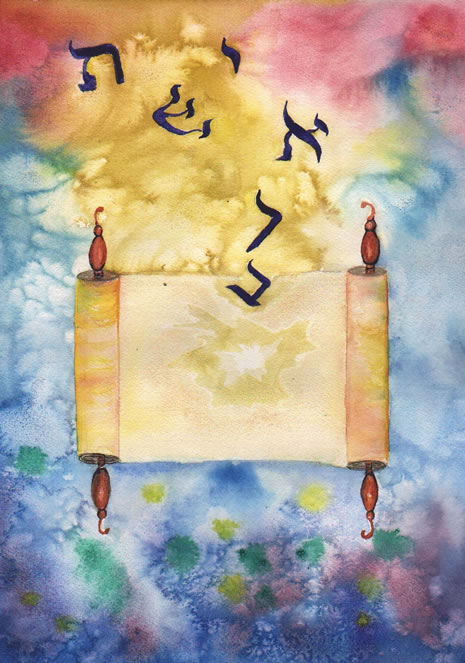
Watercolor on Paper
Artist’s Statement: Art is a human attempt to capture the beauty that exists in the world.
DID YOU KNOW?

You Can Now WhatsApp Your Favorite Chabad.org ContentAt Chabad.org we know that the power of social media isn’t the app that’s employed, but rather the human connection that’s forged through sharing. That’s why we’re constantly tweaking the tools available to add more ways to share the Chabad.org content you love with the people that matter to you.
As more and more people use their mobile devices more often (we’re certainly seeing an increase in visitors on mobile devices to Chabad.org), new apps with a focus on mobile are becoming very popular. One extremely popular mobile app is WhatsApp. We’re so pleased that starting today you can now share articles read on your mobile browser to your WhatsApp network with a tap of your finger.
It’s never been easier to share Torah, Jewish inspiration, videos and more with your friends, family or groups! All you need to do is tap the “WhatsApp” icon above and below the video or article you wish to share.
Please let us know how you like it, and if you have any suggestions of what we can do to improve your learning and sharing experience at Chabad.org.
JEWISH NEWS

Children and War: Urgent Challenge of Education in Ukraine
Working hard to accommodate the refugee influx, Or Avner educational institutes in Zhitomir need to expand.By Sarah Leah Lawent
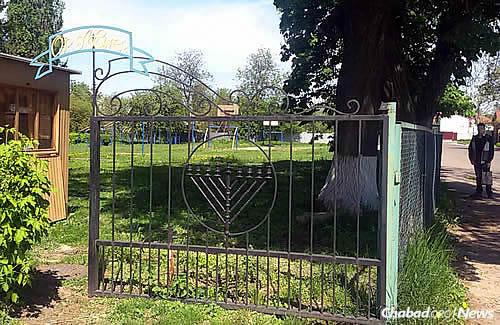
The Or Avner Day School in Zhitomir, Ukraine, part of a network of educational institutions serving Jewish children across the former Soviet Union. (Photo: Mayan Lawent)
Anna comes from a small village outside of the city of Zhitomir in western Ukraine. Like many Jewish children in rural corners of the former Soviet Union, she and her 4-year-old brother spent the initial years of their young lives barely surviving in material poverty, with no idea of their connection to Jews or Judaism. That is, until a few dedicated volunteers arrived in search of Jewish men, women and children to ensure that they would be neither forgotten nor lost.
Rabbi Shlomo Wilhelm, rabbi of the Jewish Community of Zhitomir andChabad’s director in the city, entered one such village last year with representatives of the Federation of Jewish Communities of the CIS (FJC) and was introduced to Anna’s mother. They had been briefed about her history, which, like so many in parts of the former Soviet Union, detailed a tell-tale story of violence and alcoholism in an impoverished environment.
After asking if she would like her two children to attend a Jewish school—and be housed and fed there on a full scholarship—she resisted at first. But the persistence of the emissaries in explaining the school’s warm and nurturing environment prevailed, and today, both children are adjusting, learning, playing, laughing and receiving a top-notch Jewish and secular education.
This is not a unique story. It is just one describing many of the Jewish children who have landed at Or Avner after living with dysfunctional families—children who might have faced futures with little happiness or sound prospects had nothing been done to help their circumstances.
The Federation of Jewish Communities’ Or Avner Day School in Zhitomir was founded by Rabbi Wilhelm and his wife, Esther, 12 years ago, and operates under their steadfast guidance. It is part of Or Avner’s network of 160 educational institutions serving 12,000 children across the former Soviet Union.
Or Avner is one of hundreds of projects undertaken by the FJC, which was established in November 1998 to revive the Jewish communities of the former Soviet Union. It provides humanitarian aid and Jewish education, organizes cultural events and religious services, and helps develop Jewish communities and rebuild Jewish institutions.
One of the school’s teachers, who came to Or Avner as a teenager, exudes excitement when she talks about the educational institution and opportunities it offers: “I’m from a village in the area of Berditchev,” she says, who like many in Ukraine asked not to be identified by name. “I returned to my village for a visit at one point and saw my old schoolmates—most of them are now alcoholics, involved in drugs, divorced and worse. If I had remained there, I most likely would have wound up being one of them, instead of what I have become.”
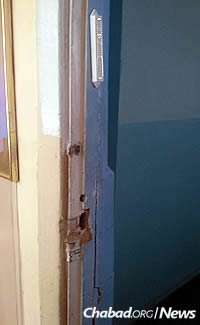
A mezuzah hangs on a doorpost that requires repair. (Photo: Mayan Lawent)
What she has become, notes Esti Wilhem, is a proud Jew connected to her heritage, and a valued member of the school staff who has three small, wonderful children of her own.
A Resource Crisis
In addition to those who have been given new beginnings, thousands more have forced to abandon their homes and flee their cities due to the conflict in east Ukraine.
Of the 90,000 Jewish residents of eastern Ukraine some 40,250 are currently in exile from their homes. Many of these refugees, specifically children, have had to face what no one should have to go through, say the Wilhelms—bombings, death, destruction, and the loss of family and friends.
Many families have landed in Zhitomir facing no home, no work, no food and no clothing.
Again, the FJC, along with the 15 Chabad emissaries and 26 Chabad institutions in eastern Ukraine, have been able to offer assistance for many of them to recover their shaky footing. All of this has been made possible, say FJC leaders, thanks to the ongoing support and partnership of the International Fellowship of Christians and Jews (IFCJ), headed by Rabbi Yechiel Eckstein. In addition to schools, support also includes a wide range of humanitarian aid projects; a network of children’s homes; food and clothing parcels; financial aid for emergency crisis; summer camps for the needy; and hot meals at the educational institutes, to name just some of the services.

The kindergarten area where children nap. More space is needed to accommodate a growing influx of refugees from war-torn parts of the country. (Photo: Mayan Lawent)
One physician from eastern Ukraine, a single mother with three young children, “had to just pick up and leave,” she recounts. “I thought I would only be here a couple of weeks and then we would be able to return to our old lives.”
Esti Wilhelm notes that while the woman’s children attended government schools, they were somewhat connected with the Jewish community and would attend activities with her children. “But when they landed in Zhitomir,” says Wilhelm, she had no work, and they had just the clothes on their backs.”
The doctor says that she is “one of the more fortunate ones in that I’ve found employment, which is a miracle in itself, and that I’ve also been able to find housing.” More importantly, she says, her children were able to attend Or Avner for free until she found work.
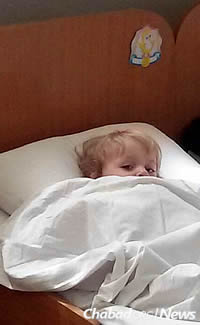
The younger set receives more than just a place to learn, play and rest; a psychologist and therapist are there for them. (Photo: Mayan Lawent)
The school provides education to many, beginning in kindergarten. There is also a children’s home and orphanage established by the Keshet foundation that the FJC runs in the city, with Jewish students of varying ages studying there—some who go on to give back to the community.
There are many wonderful stories with happy, positive endings, insists Esti Wilhelm. But there are even more in the making.
To that end, she says, the kindergarten and school must accommodate the growing needs of a population influx.
Much of the building, the furniture, the plumbing—the entire infrastructure—was built “Soviet-style,” for utilitarian purposes, and regardless of the amount of patching up now desperately needs to be refurbished, if not replaced.
Needed: More Room for Kindergarteners
Just as urgent—perhaps even more so—is the need for another room for the kindergarten to allow at least 20 more children to attend. There is not one space, one bed, left right now to squeeze more little ones in. Every inch is taken up by the kids, who receive so much more than just a place to learn, play and rest.
A psychologist on staff helps the youngsters work through their fears of war and loss, and develop healthy social interaction. A speech therapist emphasizes and practices verbal skills; many have not been socially engaged properly in these turbulent times and have trouble expressing themselves.
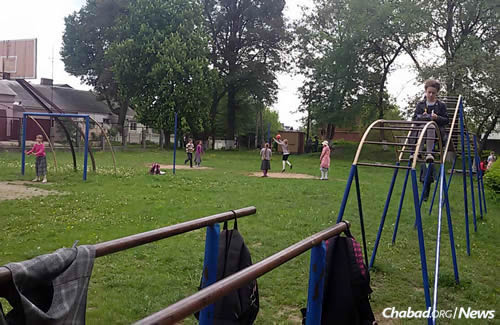
Kids fling their backpacks over poles while they take time out to play (Photo: Mayan Lawent)
Despite the age of the equipment, great care is given to make the surroundings warm and welcoming. One young woman, who has taken a break from her studies at the Beit Rivkah college in Israel in order to help the emissaries in Zhitomir, was greatly impressed by all the efforts and their results.
“You can see that everything is old, but it is so well-taken-care-of—nothing goes to waste; nothing is ignored. The amount of work and caring that the directors and the entire staff put into the school and into these children is inspirational,” says Mayan Lawent. “The four months I have been able to spend in Zhitomir have given me a look at what the work of the FJC and Chabad have accomplished—and is still accomplishing.”
The Federation of Jewish Communities has created a special video and funding page for those who wish to assist in building the new kindergarten at the Or Avner Day School in Zhitomer. To contribute to the effort, visit here.
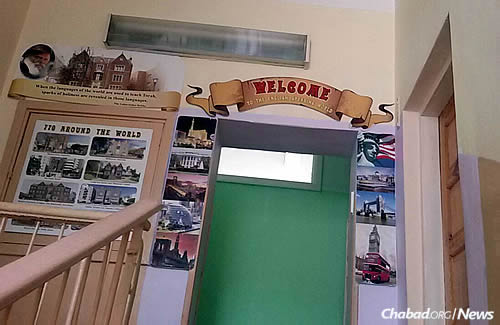
A warm entry to Or Avner, which has served as a haven for many Jewish families. (Photo: Mayan Lawent)
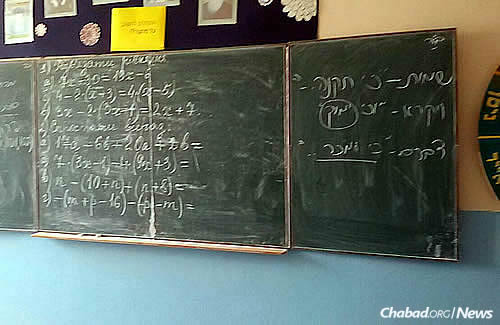
Hebrew, math ... a mix of Jewish and secular studies are taught at the Chabad-run school. (Photo: Mayan Lawent)
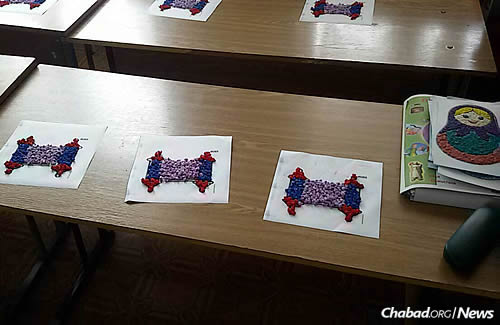
Art projects: timely Torahs in preparation of the upcoming holiday of Shavuot. (Photo: Mayan Lawent)
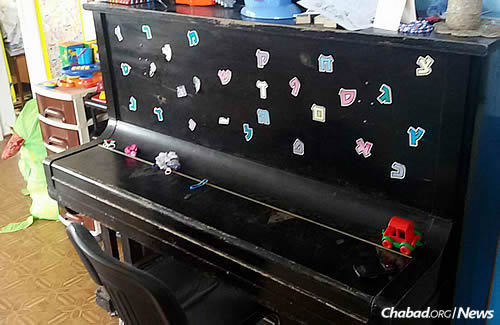
Music is also on the agenda—in this case, in the form of an older piano. (Photo: Mayan Lawent)

Child-sized bathroom facilities with instructions for boys and girls to wash up. (Photo: Mayan Lawent)
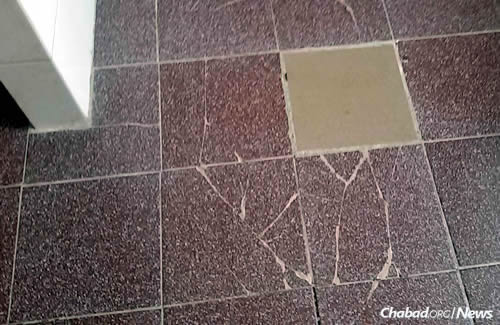
The bathroom floor, like much of the school's infrastructure, needs proper maintenance, renovation, and in some instances, complete remodeling. While the school is well-cared-for, it's showing real wear-and-tear. (Photo: Mayan Lawent)
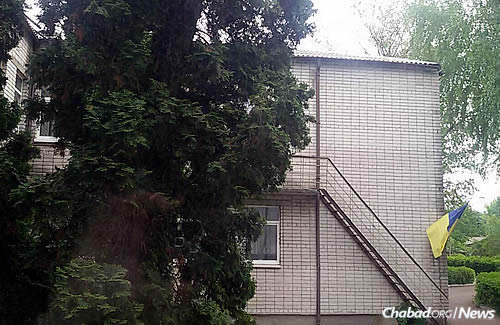
Exterior part of the school and its “Soviet-style,” utilitarian look. (Photo: Mayan Lawent)
More in Jewish News:
• Tin Roofs, Waterproof Tents to Bolster Feeble Shelter in Nepal(By Faygie Levy)

Watercolor on Paper
Artist’s Statement: Art is a human attempt to capture the beauty that exists in the world.
DID YOU KNOW?

You Can Now WhatsApp Your Favorite Chabad.org ContentAt Chabad.org we know that the power of social media isn’t the app that’s employed, but rather the human connection that’s forged through sharing. That’s why we’re constantly tweaking the tools available to add more ways to share the Chabad.org content you love with the people that matter to you.
As more and more people use their mobile devices more often (we’re certainly seeing an increase in visitors on mobile devices to Chabad.org), new apps with a focus on mobile are becoming very popular. One extremely popular mobile app is WhatsApp. We’re so pleased that starting today you can now share articles read on your mobile browser to your WhatsApp network with a tap of your finger.
It’s never been easier to share Torah, Jewish inspiration, videos and more with your friends, family or groups! All you need to do is tap the “WhatsApp” icon above and below the video or article you wish to share.
Please let us know how you like it, and if you have any suggestions of what we can do to improve your learning and sharing experience at Chabad.org.
JEWISH NEWS

Children and War: Urgent Challenge of Education in Ukraine
Working hard to accommodate the refugee influx, Or Avner educational institutes in Zhitomir need to expand.By Sarah Leah Lawent

The Or Avner Day School in Zhitomir, Ukraine, part of a network of educational institutions serving Jewish children across the former Soviet Union. (Photo: Mayan Lawent)
Anna comes from a small village outside of the city of Zhitomir in western Ukraine. Like many Jewish children in rural corners of the former Soviet Union, she and her 4-year-old brother spent the initial years of their young lives barely surviving in material poverty, with no idea of their connection to Jews or Judaism. That is, until a few dedicated volunteers arrived in search of Jewish men, women and children to ensure that they would be neither forgotten nor lost.
Rabbi Shlomo Wilhelm, rabbi of the Jewish Community of Zhitomir andChabad’s director in the city, entered one such village last year with representatives of the Federation of Jewish Communities of the CIS (FJC) and was introduced to Anna’s mother. They had been briefed about her history, which, like so many in parts of the former Soviet Union, detailed a tell-tale story of violence and alcoholism in an impoverished environment.
After asking if she would like her two children to attend a Jewish school—and be housed and fed there on a full scholarship—she resisted at first. But the persistence of the emissaries in explaining the school’s warm and nurturing environment prevailed, and today, both children are adjusting, learning, playing, laughing and receiving a top-notch Jewish and secular education.
This is not a unique story. It is just one describing many of the Jewish children who have landed at Or Avner after living with dysfunctional families—children who might have faced futures with little happiness or sound prospects had nothing been done to help their circumstances.
The Federation of Jewish Communities’ Or Avner Day School in Zhitomir was founded by Rabbi Wilhelm and his wife, Esther, 12 years ago, and operates under their steadfast guidance. It is part of Or Avner’s network of 160 educational institutions serving 12,000 children across the former Soviet Union.
Or Avner is one of hundreds of projects undertaken by the FJC, which was established in November 1998 to revive the Jewish communities of the former Soviet Union. It provides humanitarian aid and Jewish education, organizes cultural events and religious services, and helps develop Jewish communities and rebuild Jewish institutions.
One of the school’s teachers, who came to Or Avner as a teenager, exudes excitement when she talks about the educational institution and opportunities it offers: “I’m from a village in the area of Berditchev,” she says, who like many in Ukraine asked not to be identified by name. “I returned to my village for a visit at one point and saw my old schoolmates—most of them are now alcoholics, involved in drugs, divorced and worse. If I had remained there, I most likely would have wound up being one of them, instead of what I have become.”

A mezuzah hangs on a doorpost that requires repair. (Photo: Mayan Lawent)
What she has become, notes Esti Wilhem, is a proud Jew connected to her heritage, and a valued member of the school staff who has three small, wonderful children of her own.
A Resource Crisis
In addition to those who have been given new beginnings, thousands more have forced to abandon their homes and flee their cities due to the conflict in east Ukraine.
Of the 90,000 Jewish residents of eastern Ukraine some 40,250 are currently in exile from their homes. Many of these refugees, specifically children, have had to face what no one should have to go through, say the Wilhelms—bombings, death, destruction, and the loss of family and friends.
Many families have landed in Zhitomir facing no home, no work, no food and no clothing.
Again, the FJC, along with the 15 Chabad emissaries and 26 Chabad institutions in eastern Ukraine, have been able to offer assistance for many of them to recover their shaky footing. All of this has been made possible, say FJC leaders, thanks to the ongoing support and partnership of the International Fellowship of Christians and Jews (IFCJ), headed by Rabbi Yechiel Eckstein. In addition to schools, support also includes a wide range of humanitarian aid projects; a network of children’s homes; food and clothing parcels; financial aid for emergency crisis; summer camps for the needy; and hot meals at the educational institutes, to name just some of the services.

The kindergarten area where children nap. More space is needed to accommodate a growing influx of refugees from war-torn parts of the country. (Photo: Mayan Lawent)
One physician from eastern Ukraine, a single mother with three young children, “had to just pick up and leave,” she recounts. “I thought I would only be here a couple of weeks and then we would be able to return to our old lives.”
Esti Wilhelm notes that while the woman’s children attended government schools, they were somewhat connected with the Jewish community and would attend activities with her children. “But when they landed in Zhitomir,” says Wilhelm, she had no work, and they had just the clothes on their backs.”
The doctor says that she is “one of the more fortunate ones in that I’ve found employment, which is a miracle in itself, and that I’ve also been able to find housing.” More importantly, she says, her children were able to attend Or Avner for free until she found work.

The younger set receives more than just a place to learn, play and rest; a psychologist and therapist are there for them. (Photo: Mayan Lawent)
The school provides education to many, beginning in kindergarten. There is also a children’s home and orphanage established by the Keshet foundation that the FJC runs in the city, with Jewish students of varying ages studying there—some who go on to give back to the community.
There are many wonderful stories with happy, positive endings, insists Esti Wilhelm. But there are even more in the making.
To that end, she says, the kindergarten and school must accommodate the growing needs of a population influx.
Much of the building, the furniture, the plumbing—the entire infrastructure—was built “Soviet-style,” for utilitarian purposes, and regardless of the amount of patching up now desperately needs to be refurbished, if not replaced.
Needed: More Room for Kindergarteners
Just as urgent—perhaps even more so—is the need for another room for the kindergarten to allow at least 20 more children to attend. There is not one space, one bed, left right now to squeeze more little ones in. Every inch is taken up by the kids, who receive so much more than just a place to learn, play and rest.
A psychologist on staff helps the youngsters work through their fears of war and loss, and develop healthy social interaction. A speech therapist emphasizes and practices verbal skills; many have not been socially engaged properly in these turbulent times and have trouble expressing themselves.

Kids fling their backpacks over poles while they take time out to play (Photo: Mayan Lawent)
Despite the age of the equipment, great care is given to make the surroundings warm and welcoming. One young woman, who has taken a break from her studies at the Beit Rivkah college in Israel in order to help the emissaries in Zhitomir, was greatly impressed by all the efforts and their results.
“You can see that everything is old, but it is so well-taken-care-of—nothing goes to waste; nothing is ignored. The amount of work and caring that the directors and the entire staff put into the school and into these children is inspirational,” says Mayan Lawent. “The four months I have been able to spend in Zhitomir have given me a look at what the work of the FJC and Chabad have accomplished—and is still accomplishing.”
The Federation of Jewish Communities has created a special video and funding page for those who wish to assist in building the new kindergarten at the Or Avner Day School in Zhitomer. To contribute to the effort, visit here.

A warm entry to Or Avner, which has served as a haven for many Jewish families. (Photo: Mayan Lawent)

Hebrew, math ... a mix of Jewish and secular studies are taught at the Chabad-run school. (Photo: Mayan Lawent)

Art projects: timely Torahs in preparation of the upcoming holiday of Shavuot. (Photo: Mayan Lawent)

Music is also on the agenda—in this case, in the form of an older piano. (Photo: Mayan Lawent)

Child-sized bathroom facilities with instructions for boys and girls to wash up. (Photo: Mayan Lawent)

The bathroom floor, like much of the school's infrastructure, needs proper maintenance, renovation, and in some instances, complete remodeling. While the school is well-cared-for, it's showing real wear-and-tear. (Photo: Mayan Lawent)

Exterior part of the school and its “Soviet-style,” utilitarian look. (Photo: Mayan Lawent)
More in Jewish News:
• Tin Roofs, Waterproof Tents to Bolster Feeble Shelter in Nepal(By Faygie Levy)
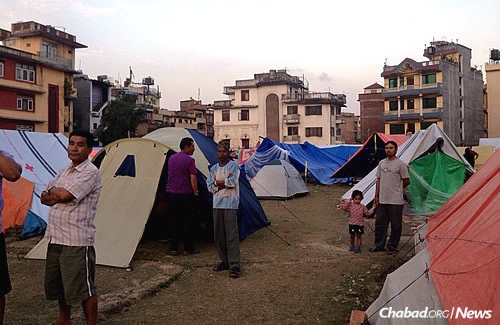
Makeshift tents are being replaced with waterproof tents where they can, as many Nepali people remain living outside and will not be adequately protected when monsoon season begins.
Three weeks after a massive 7.8 earthquake hit Nepal—followed by one of nearly the same magnitude last week—the South Asian nation remains in shambles, with an eye on upcoming monsoon season that could make life go from bad to worse.
Donations have been pouring in, and the government is doing what it can to help the thousands of homeless and injured Nepali people. For its part, Chabadof Nepal, which was thrust into the midst of rescue-and-relief efforts immediately after disaster struck, continues to assist locals as most of the Israeli and other tourists have left the country.
One major goal right now is to construct stronger dwellings for those living in open fields and makeshift “tent cities.” That comes in the form of sturdy, waterproof tents and tin roofs on existing shelters to prepare for the winds and heavy rains expected with the start of monsoon season next month.
Rabbi Chezky Lifshitz, co-director of Chabad of Nepal with his wife, Chani, notes that the Chabad House in Kathmandu has also suffered some damage, estimating repair costs at $20,000.
But the emphasis remains on the hundreds of thousands of people who have lost their homes in the earthquake and the subsequent tremors that continue to rattle Nepal and agitate already damaged buildings.
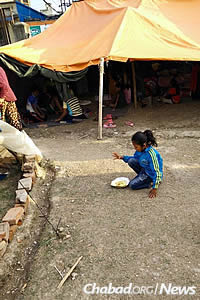
A little girl eats near the Chabad House in Kathmandu, which continues to provide food for those in need.
“We are helping to rebuild villages that were destroyed,” says the rabbi, turning sights on long-term survival. “We brought in contractors from Israel who are experts in the field of quick construction, who can build a home within 10 days. Many are left with no roofs over their heads, and we want to rebuild as much as possible before monsoon season in just a few weeks.”
Food, Medicine and More
While Chabad is far from the only aid organization assisting on the ground, it proved crucial in rescuing stranded tourists after the initial earthquake, and feeding and housing anyone coming to the center for help.
Lifshitz notes that people have responded to calls for waterproof tents—hundreds have been distributed—but more permanent structures are still needed.
Food and medical supplies also remain a concern. According to the Lifshitzes, some isolated places still don’t have adequate food, so Chabad has been sending out food packages, as the government is overwhelmed with immediate needs.
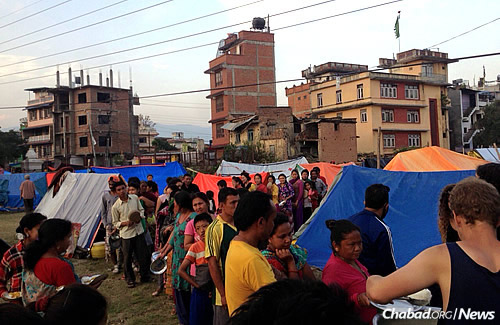
Lining up with tin plates for food being distributed outside the Chabad House in Kathmandu.
An estimated 30 to 40 people are still at the Chabad House, which, while still standing, has been damaged by the quakes. Says Lifshitz: “It’s possible that after inspection, we may need to move to a different place.”
The couple sent their three young children to Israel weeks ago to stay with their grandparents.
Noting that most tourists have returned home, British volunteer Yehuda Rose, who has been helping in Nepal since shortly after the first earthquake, says those there are doing what they can in a tense and difficult time. He adds that local employees of the Chabad House have returned to their homes and villages to deal with matters there, and comfort their friends and families.
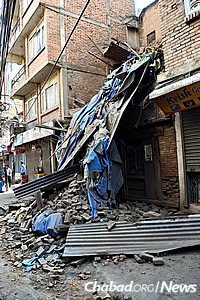
More destruction can be seen after another significant earthquake rattled Nepal last week.
Meanwhile, in a posting on Facebook, Chani Lifshitz sought to explain what keeps them so motivated and focused. Noting that her grandmother was imprisoned in the Auschwitz concentration camp during World War II after having lost her home and family, what kept her going was her dreams—dreams of one day having someone to keep her warm, to feed her, to sing to her.
She correlated that to the situation of the Nepali people, that such dreams are what they have now.
Lifshitz writes: “Yes, it’s possible to take everything from a person, aside from [their] dreams. And that good people that will come and actualize [those] dreams.
“May we merit to be on the side of the giver who actualizes dreams.”
To help with the earthquake relief effort, visit the special relief fund page:www.Chabad.org/Nepal.

Rabbi Chezky Lifshitz, co-director of Chabad of Nepal with his wife, Chani, with medical supplies.
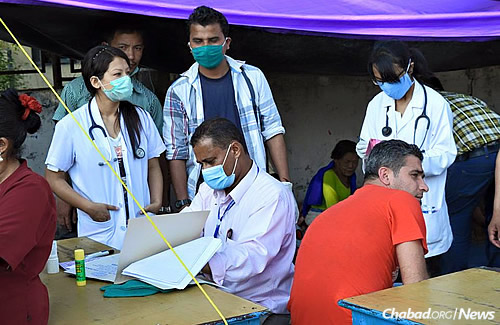
Aid and medical workers treat the injured and ill, as food and water remain in limited supply.

Workers put up waterproof tents, which will be hardier when the rains come in June. Contractors are also evaluating damages to villages and trying to supply and outfit shelters with tin roofs.
• Collegian Finds Inventive ‘Sandy Koufax’ Solution for Shabbat Commencement Speech (By Carin M. Smilk)
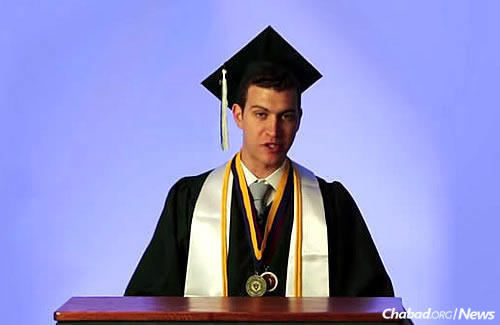
With the help of Binghamton University administrators, Don Greenberg worked out how to deliver a commencement speech for the school’s Watson School of Engineering on Saturday, May 16, so as not to be in violation of Jewish law.
They might come up with a new word for Don Greenberg’s commencement speech at Binghamton University in Upstate New York. Something like ... “valedictation.”
The graduating college senior was nominated to be this year’s commencement speaker for the school’s Watson School of Engineering on May 16. However, when the 22-year-old learned that the ceremony was on Saturday—the JewishSabbath—it appeared that it would not be possible. The issue surrounded the use of a microphone.
After consulting with a number of rabbis, Greenberg told administrators at the New York state campus that according to Jewish law, he could not use the microphone at the ceremony.
The Rohr Chabad Center for Jewish Student Life at Binghamton University
“I’m reminded of when Sandy Koufax refused to pitch during the first game of the 1965 World Series, which coincided with Yom Kippur eve,” says Rabbi Aaron Slonim, executive director of the Rohr Chabad Center for Jewish Student Life at Binghamton University, a Jewish campus organization where Greenberg is an active member. “His courage gave many Jews the strength to be unabashed of their Judaism.”
”I was considering not speaking,” acknowledges Greenberg, who notes that during his four years there, he did no schoolwork on Shabbat. He would work right up until Friday night and then stop for the weekly holiday. “I wasn’t sure what the protocol was or what would be right for my graduating class. I went out on a limb, and the school made it work.”
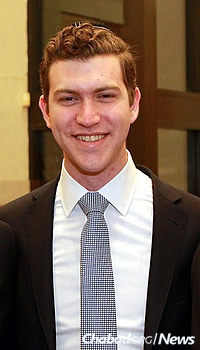
Binghamton University graduating senior Don Greenberg, 22
With the help of university administrators, Greenberg has found a way to deliver the speech—a rather innovative way at that. It was taped on Wednesday at a podium in front of a blue background as he stood in full graduation regalia.
“So ... this is awkward,” began Greenberg, in the introduction to his talk. “I know this is sort of an interesting arrangement, but I want to first and foremost express my tremendous gratitude for the school for making it happen.
“The problem is that Saturday is the Jewish Sabbath, a day that as a central part of my Orthodox upbringing is free of all electronics, like, say, a microphone, as well as writing, driving, cooking and lots of other things,” he explains. “It’s a time to relax with family and friends, and forget about the week. And it’s a big part of my life.
“My family walked here this morning, and we will walk to Chabad at noon for the traditional Shabbat lunch.”
Indeed, Chabad has been an important part of his college life. He was involved there from the get-go, attending weekly Friday-night Shabbat dinners, holiday programs and other events. “I met most of my friends through Chabad at Binghamton. It’s just one of a kind here, just terrific! The amount of programming and vibrancy of the Jewish community here is on a different level than other places.
”And the school itself,” he continues, “is very cognizant and accommodating to different groups.”
‘Great Pride and Strength’
This Saturday, when some 2,500 students and their families gather on campus for the engineering ceremony, they will watch Greenberg’s pre-recorded commencement speech on jumbo screens on either side of the stage.
“Don’s unwavering commitment to Shabbat and to Judaism is a source of great pride and strength to Jewish students here at Binghamton University, and in particular, to Jewish college students around the world,” says Slonim. “I also want to express my gratitude to everyone at Binghamton University who did not make Don choose between his religious conviction and this remarkable opportunity. This incident only highlights this outstanding truth about our campus culture and its values.”
Greenberg is graduating with a triple degree in computer science, math and finance. The native of Teaneck, N.J.—who has three siblings also heavily involved in Jewish life, including a younger brother now studying in Israel—plans to begin his career this summer in New York City, working in telecommunications equity research.
In fact, his status as a former collegian is now practically official. He took his last final today, on the subject of architecture, finishing around noon.
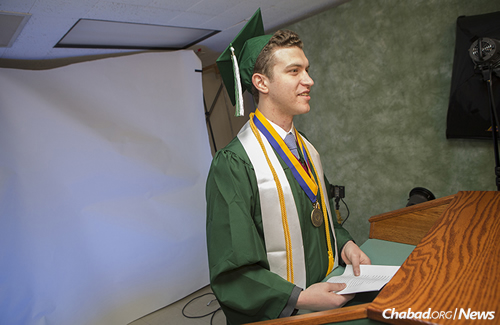
Greenberg's commencement speech was taped on Wednesday at a podium as he stood in full graduation regalia. (Photo: Jonathan Cohen/Binghamton University/RNS)
<script language="javascript" type="text/javascript" src="http://embed.chabad.org/multimedia/mediaplayer/embedded/embed.js.asp?aid=2951405&width=auto&height=auto"></script><span style="clear:both;" class="lb" id="lbdiv">Visit <a href="http://www.chabad.org/multimedia/default_cdo/aid/591213/jewish/Video.htm">Jewish.TV</a> for more <a href="http://www.chabad.org/multimedia/default_cdo/aid/591213/jewish/Video.htm">Jewish videos</a>.</span>

• Rabbinical Students Off to Boost Remote Places for Shavuot(By Menachem Posner)
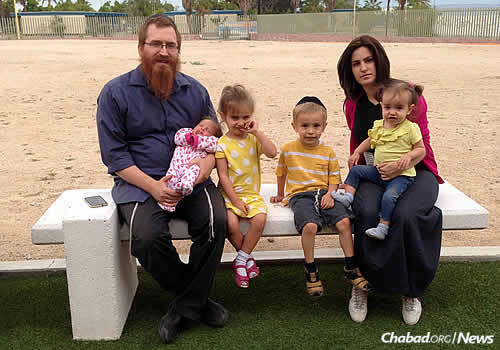
Rabbi Alexander and Esther Piekarski, co-directors of Beth Yona-Chabad Jewish Community of La Paz, Mexico, and their children, are looking forward to rabbinical students joining them for Shavuot, thanks to a new program.
Shavuot presented some problems last year for Rabbi Alexander and EstherPiekarski, co-directors of Beth Yona-Chabad Jewish Community of La Paz, Mexico.
With many locals away to escape the scorching summer heat and with the holiday not as widely celebrated as Passover or Chanukah, shoring up aminyan of 10 men to hold prayer services was a real challenge. The tradition of serving a dairy meal also becomes difficult in a more remote community with no ready access to kosher cheeses and milk.
This year, however, they expect to celebrate the holiday with ease due to a program initiated by an anonymous donor working with Merkos L’Inyonei Chinuch, the educational arm of the Chabad-Lubavitch movement.
The initiative is part of the Ufaratzta Circle, which unites and serves Chabad-Lubavitch emissary families in remote locations.
“They have their own unique challenges, living far from peers, homeschooling their children and pretty much doing everything on their own,” explains Rabbi Mendy Kotlarsky, executive director of Merkos Suite 302 in the Crown Heights neighborhood of Brooklyn, N.Y. “The Ufaratzta Circle provides support, bringing them together with families in the same situation.”
“The person sponsoring this Shavuot project travels often and sees firsthand how much these shluchim families sacrifice to be able to be there for their communities,” says Rabbi Zalman Wolowik, co-director ofChabad of the Five Towns in Cedarhurst, N.Y., who was instrumental in arranging the program. “He felt that sending them company for the holiday would go a long way to alleviate some of their loneliness, and bring them and their communities some holiday spirit.”
To that end, the office will be sending approximately 80 rabbinical students to spend Shavuot with isolated Chabad rabbis and their families, according Rabbi Schneur Najar, who directs the “Roving Rabbis” program.
Destinations include U.S. states like Utah, Nebraska, Idaho and Hawaii, in addition to countries such as Jamaica and Nova Scotia, to name just a few.
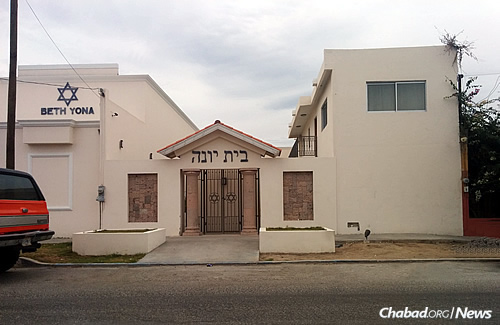
It can be a challenge to get a minyan in small Jewish communities like of La Paz, Mexico, at certain times of the year.
Torah, All-Night Learning and More
Piekarski expects that the young men will bring a buzz to his community of several hundred Jewish members well in advance of their arrival: “The very fact that Chabad headquarters will be sending people here sends a message that this holiday is important.”
And the holiday is indeed very important: Shavuot, meaning “weeks” in Hebrew, celebrates G‑d giving the Torah to the Jewish people on Mount Sinai more than 3,300 years ago. Every year on Shavuot—which this year begins at sunset on Saturday, May 23, and continues through nightfall on Monday, May, 25—the Jewish people renew their acceptance of G‑d’s gift, and G‑d “re-gives” the Torah.
In addition to services comes the reading of the Ten Commandments, which the Lubavitcher Rebbe—Rabbi Menachem M. Schneerson, of righteous memory—encouraged all Jewish men, women and children to hear. The visiting rabbinical students will also join the rabbi for an all-night learning session and interact with community members throughout the course of the two-day holiday.
To top it off, the young men will fly down with suitcases fill of kosher dairy supplies, including some special treats for the four Piekarski children, the oldest of whom is 4.
“Beyond the technical details of what they will or will not do,” says Rabbi MosheKotlarsky, vice chairman of Merkos L’Inyonei Chinuch, “their very presence brings to life the Chassidic saying that ‘a Chassid is never alone.’
“We are one extended family.”
FOR THE KIDS

Decorative Flower Vase
You will need:
• Be There!

Special message to all Boys and Girls!
Shavuot is the Festival of the Giving of the Torah.
When G‑d gave the Torah to the Jewish people, the Jewish children were the guarantors! G‑d knew that He could count on the Jewish boys and girls to make sure the Jewish people would love the Torah, learn it, and do its holy mitzvahs.
Every year, on the same date of the giving of the Torah, we celebrate this special day by going to the synagogue and hearing the Ten Commandments.
Remember! YOU are the guarantors of the Torah. So make sure to be there! (And bring your friends along too.)
On Sunday, May 24, 2015, make sure to go to your local synagogue and hear the Ten Commandments.
Click here to find a synagogue near you.
Other ways to prepare for this special holiday on our site:

• Rabbinical Students Off to Boost Remote Places for Shavuot(By Menachem Posner)

Rabbi Alexander and Esther Piekarski, co-directors of Beth Yona-Chabad Jewish Community of La Paz, Mexico, and their children, are looking forward to rabbinical students joining them for Shavuot, thanks to a new program.
Shavuot presented some problems last year for Rabbi Alexander and EstherPiekarski, co-directors of Beth Yona-Chabad Jewish Community of La Paz, Mexico.
With many locals away to escape the scorching summer heat and with the holiday not as widely celebrated as Passover or Chanukah, shoring up aminyan of 10 men to hold prayer services was a real challenge. The tradition of serving a dairy meal also becomes difficult in a more remote community with no ready access to kosher cheeses and milk.
This year, however, they expect to celebrate the holiday with ease due to a program initiated by an anonymous donor working with Merkos L’Inyonei Chinuch, the educational arm of the Chabad-Lubavitch movement.
The initiative is part of the Ufaratzta Circle, which unites and serves Chabad-Lubavitch emissary families in remote locations.
“They have their own unique challenges, living far from peers, homeschooling their children and pretty much doing everything on their own,” explains Rabbi Mendy Kotlarsky, executive director of Merkos Suite 302 in the Crown Heights neighborhood of Brooklyn, N.Y. “The Ufaratzta Circle provides support, bringing them together with families in the same situation.”
“The person sponsoring this Shavuot project travels often and sees firsthand how much these shluchim families sacrifice to be able to be there for their communities,” says Rabbi Zalman Wolowik, co-director ofChabad of the Five Towns in Cedarhurst, N.Y., who was instrumental in arranging the program. “He felt that sending them company for the holiday would go a long way to alleviate some of their loneliness, and bring them and their communities some holiday spirit.”
To that end, the office will be sending approximately 80 rabbinical students to spend Shavuot with isolated Chabad rabbis and their families, according Rabbi Schneur Najar, who directs the “Roving Rabbis” program.
Destinations include U.S. states like Utah, Nebraska, Idaho and Hawaii, in addition to countries such as Jamaica and Nova Scotia, to name just a few.

It can be a challenge to get a minyan in small Jewish communities like of La Paz, Mexico, at certain times of the year.
Torah, All-Night Learning and More
Piekarski expects that the young men will bring a buzz to his community of several hundred Jewish members well in advance of their arrival: “The very fact that Chabad headquarters will be sending people here sends a message that this holiday is important.”
And the holiday is indeed very important: Shavuot, meaning “weeks” in Hebrew, celebrates G‑d giving the Torah to the Jewish people on Mount Sinai more than 3,300 years ago. Every year on Shavuot—which this year begins at sunset on Saturday, May 23, and continues through nightfall on Monday, May, 25—the Jewish people renew their acceptance of G‑d’s gift, and G‑d “re-gives” the Torah.
In addition to services comes the reading of the Ten Commandments, which the Lubavitcher Rebbe—Rabbi Menachem M. Schneerson, of righteous memory—encouraged all Jewish men, women and children to hear. The visiting rabbinical students will also join the rabbi for an all-night learning session and interact with community members throughout the course of the two-day holiday.
To top it off, the young men will fly down with suitcases fill of kosher dairy supplies, including some special treats for the four Piekarski children, the oldest of whom is 4.
“Beyond the technical details of what they will or will not do,” says Rabbi MosheKotlarsky, vice chairman of Merkos L’Inyonei Chinuch, “their very presence brings to life the Chassidic saying that ‘a Chassid is never alone.’
“We are one extended family.”
FOR THE KIDS

Decorative Flower Vase
You will need:
- 1 clean and empty plastic container (yogurt containers are good for smaller flowers, larger containers are better for taller flowers)
- Paint brush
- Tissue paper, construction paper or scrapbook paper
- Mod-Podge
- Tear the paper into small pieces.
- Brush some Mod-Podge onto part of the container and cover with piece of paper.
- Continue until the entire container is covered. If you’re using thinner paper, like tissue paper, you may want to do a second layer.
- When you’re done, gently brush over all the paper with Mod-Podge and set aside to dry. (Mod-Podge has a strong smell, so you might want to put it outside to dry.)
- Fill with flowers and display.
- © Copyright, all rights reserved. If you enjoyed this article, we encourage you to distribute it further, provided that you comply with Chabad.org's copyright policy.
• Be There!

Special message to all Boys and Girls!
Shavuot is the Festival of the Giving of the Torah.
When G‑d gave the Torah to the Jewish people, the Jewish children were the guarantors! G‑d knew that He could count on the Jewish boys and girls to make sure the Jewish people would love the Torah, learn it, and do its holy mitzvahs.
Every year, on the same date of the giving of the Torah, we celebrate this special day by going to the synagogue and hearing the Ten Commandments.
Remember! YOU are the guarantors of the Torah. So make sure to be there! (And bring your friends along too.)
On Sunday, May 24, 2015, make sure to go to your local synagogue and hear the Ten Commandments.
Click here to find a synagogue near you.
Other ways to prepare for this special holiday on our site:
- Read all about what happened to make Shavuot a special day: The Story of Shavuot.
- Read stories on how people throughout the generations celebrated Shavuot.
© Copyright, all rights reserved. If you enjoyed this article, we encourage you to distribute it further, provided that you comply with Chabad.org's copyright policy.
___________________________________
___________________________________
ReplyDeleteReally its very useful information that you have shared and thanks for sharing the information with us.
Best Bridal Makeup Artist in Erode